Piezoelectric Impedance-Based Structural Health Monitoring of Wind Turbine Structures: Current Status and Future Perspectives
Abstract
:1. Introduction
2. Potential Damages in Wind Turbines
2.1. Blade Failure
- Leading-edge erosion is mainly due to airborne particulates in the form of rain, hailstone, sea spray, dust and sand, and UV light and humidity/moisture. As reported in [59], leading-edge erosion can occur after only two years of wind turbine operation, and it is dependent on the site.
- Structural fatigue damage can occur when the wind turbine is subjected to repeated loads during its life cycle induced by wind. The turbine’s cyclic starts and stops, with yaw error, yaw motion, and vibrational resonance-induced loads from the dynamics of the structure.
- Damage from icing is caused by the accretion of ice or snow on the blade structures exposed to the icing atmosphere. As reported in [6], there are two distinguished types of atmospheric icing, in-cloud icing (rime ice or glaze) and precipitation icing (freezing rain or drizzle, wet snow). Icing causes added mass and could induce unbalanced vibrations of the blade, resulting in considerable reductions in the economic efficiency of the wind energy project.
2.2. Tower Failure
- Fatigue cracks. Different materials can be used for constructing wind turbine towers. From the beginning, a wind turbine tower was made of steel truss-like structures with many connections that could be easily corroded. With increased turbine capacity, steel tubular tubes are preferred for the wind turbine tower design. Harte et al. [61] reported that a steel tubular tower with a height of over 85 m is extremely challenging to balance the dynamical excitation. A concrete tower can be an alternation, but it faces thermal constraints that cause cracking damages in the tower, reducing the stiffness of the whole system. On the other hand, wind turbine towers are often subjected to repeated loads during their life cycle, which can result in fatigue cracks that can expand and carry potential, leading to the tragic collapse of a whole tower.
- Joint failure. In the steel tubular tower, the segments are assembled by high-strength bolts, which are indeed hot spots in the tower. The self-looseness is one of the main reasons for the failure of a bolted joint, especially under transverse loads [62,63]. Regarding the wind tower joint, the bolt failures such as loose and broken could be found during harvesting wind energy [64]. Imbalanced loads across a clamping bolted connection could cause local plastic zones and create proper conditions for corrosion damages [60]. Figure 4a shows the scene of the tower’s structural failure at the wind farm Abuela de Santa Ana in Spain in 2008 [65]. A field investigation found signs of corrosion in the damaged flange section of the joint, which eventually led to the failure of the whole tower, as shown in Figure 4b.
- Storm-induced failure. A turbine tower could be broken and toppled over during a storm, as reported in [66]. Accidents are ranked the third most common cause of failure [60]. Cheng and Xu [67] investigated the structural failure of wind turbines in China’s Shanwei City caused by the super typhoon Usagi in 2013. The representative tower failure is presented in Figure 4c. The local buckling was observed at the shell wall thickness transition zone in the tower during the typhoon, as depicted in Figure 4d. Their study further reveals that the tubular tower collapsed at a hub wind speed lower than the design survival wind speed. A finite element model was constructed to predict the failure modes and failure locations in the tubular towers caused by the Usagi typhoon [68].
- Improper installation. In some realistic situations, faulty construction and poor quality control are responsible for the collapse of new turbine structures [3]. As reported in [64], faulty bolt installation related to an insufficient preload at the joint induced the failure of a wind turbine tower in Sweden. In 2008, the Jangmi typhoon struck Taiwan, resulting in strong winds and heavy rains that caused the collapse of a wind turbine [4]. The actual views of the fractured tubular tower section and fractured bolts are depicted in Figure 4e,f, respectively. Chou et al. [4] conducted a failure analysis of the collapsed wind turbine and found that the designed strength of the bolts and the used ones during the construction was different.
- Lightning damage. Lightning can cause severe damage and even destroy the tower. Wind turbine towers are getting so high and attractive to lightning, primarily when they are frequently located in flat areas with nothing around. Unlike the blades, the tower’s damage related to lightning is rarely observed. A survey of wind turbine tower collapse cases reported that lightning produced only two incidents of the tower collapse, with the occurrence of lightning-related damage being 2.8% [60].
2.3. Substructure and Foundation Failures
- Concrete foundation damage. In Germany, in 2000, four turbines experienced sudden and total collapse due to concrete damage at the base. This led to the shutdown of forty-four similar turbines for pending investigation [66]. The steel tower is clamped to the foundation through pre-stalled anchor bolts, and there are many problems in the mortar grout between the steel flange and the foundation. The potential damages can be the vertical shrinkage cracks, the side excess material, the weak mortar grout caused by the separation of the motor, and the voids between the concrete and the tower segments [69]. The combination of the stresses caused by the serviceability load and the thermal stresses could result in cracks in a high concrete foundation pedestal. Cracks can propagate and lead water and dirt from the outside to the inside of the foundation pedestal. Further, the cracks could potentially occur in the transition zones between the insert ring of the tower and the concrete foundation, as reported in [69].
- Corrosion, scouring, grounded connection failure, and fatigue damage in substruction. The offshore environment is one of the harshest. Under the offshore atmosphere, many potential damages can occur in the substructure and foundation of offshore wind turbines, including corrosion [71,72], scours in the sea bed [73], failure of the grouted connections [74], and cracks in welding/bolted joints [75]. An example of corrosion that has occurred inside a substructure is illustrated in Figure 5a. Many factors influence the rate of corrosion in the offshore atmosphere, such as temperature, humidity, biological organisms, and airborne contaminants [3]. When a wind turbine is placed offshore, locally increased current and wave motions are induced around the structure, resulting in scouring, as depicted in Figure 5b [76]. Grouted connections are commonly used as the structural joint between the substructure and the foundation of an offshore wind turbine [74]. A typical failure of a grouted connection is shown in Figure 5c. Under the different ambient conditions and high dynamical loads caused by waves and wind, the grouted connections are potentially damaged, leading to a reduction in their mechanical stability [77,78], especially severe fatigue damages [74]. The combination of wave and wind loading could also result in fatigue damage in a tripod support structure. The previous analysis of fatigue damage assessment [75] shows that the hot spots (the most severe regions) in the tripod are at the joints between the central column and the bracing members and between the pile and the brace (see Figure 5d).
3. Fundamentals of Impedance-Based SHM
3.1. Impedance Sensing Technology
3.1.1. PZT-Driven System
3.1.2. Impedance Analyzer
Wired Impedance Analyzers
Wireless Impedance Analyzers
3.2. Damage Identification Method
3.2.1. Traditional Metrics
3.2.2. Advanced Damage Identification Algorithms
Advanced Statistical Index
Machine Learning Algorithms
4. Current Status of Impedance-Based SHM of Wind Turbines
4.1. SHM of Wind Turbine Blades
4.2. SHM of Wind Turbine Tower
4.2.1. Monitoring of Tower Joint
4.2.2. Monitoring of Tower Segment
4.3. SHM of Substructure and Foundation
5. Future Perspectives of Impedance-Based SHM of Wind Turbines
5.1. Blade Monitoring
5.2. Tubular Tower Monitoring
5.3. Substructure and Foundation Monitoring
6. Conclusions
- (1)
- Focusing on the applicability of the impedance-based technique for SHM of different structural components such as blades, towers, substructures, and foundations;
- (2)
- Identifying research needs for improving the performance of the impedance-based SHM of wind turbines;
- (3)
- Proposing innovative concepts for the future development of an effective impedance-based SHM system in the green energy field.
Author Contributions
Funding
Acknowledgments
Conflicts of Interest
References
- Luderer, G.; Pietzcker, R.C.; Carrara, S.; de Boer, H.S.; Fujimori, S.; Johnson, N.; Mima, S.; Arent, D. Assessment of wind and solar power in global low-carbon energy scenarios: An introduction. Energy Econ. 2017, 64, 542–551. [Google Scholar] [CrossRef] [Green Version]
- Wiser, R.; Rand, J.; Seel, J.; Beiter, P.; Baker, E.; Lantz, E.; Gilman, P. Expert elicitation survey predicts 37% to 49% declines in wind energy costs by 2050. Nat. Energy 2021, 6, 555–565. [Google Scholar] [CrossRef]
- Ciang, C.C.; Lee, J.-R.; Bang, H.-J. Structural health monitoring for a wind turbine system: A review of damage detection methods. Meas. Sci. Technol. 2008, 19, 122001. [Google Scholar] [CrossRef] [Green Version]
- Chou, J.-S.; Tu, W.-T. Failure analysis and risk management of a collapsed large wind turbine tower. Eng. Fail. Anal. 2011, 18, 295–313. [Google Scholar] [CrossRef]
- Adedipe, O.; Brennan, F.; Kolios, A. Review of corrosion fatigue in offshore structures: Present status and challenges in the offshore wind sector. Renew. Sustain. Energy Rev. 2016, 61, 141–154. [Google Scholar] [CrossRef]
- Katsaprakakis, D.A.; Papadakis, N.; Ntintakis, I. A Comprehensive Analysis of Wind Turbine Blade Damage. Energies 2021, 14, 5974. [Google Scholar] [CrossRef]
- Shafiee, M.; Brennan, F.; Espinosa, I.A. A parametric whole life cost model for offshore wind farms. Int. J. Life Cycle Assess. 2016, 21, 961–975. [Google Scholar] [CrossRef] [Green Version]
- Shafiee, M.; Zhou, Z.; Mei, L.; Dinmohammadi, F.; Karama, J.; Flynn, D. Unmanned Aerial Drones for Inspection of Offshore Wind Turbines: A Mission-Critical Failure Analysis. Robotics 2021, 10, 26. [Google Scholar] [CrossRef]
- Martinez-Luengo, M.; Kolios, A.; Wang, L. Structural health monitoring of offshore wind turbines: A review through the Statistical Pattern Recognition Paradigm. Renew. Sustain. Energy Rev. 2016, 64, 91–105. [Google Scholar] [CrossRef] [Green Version]
- Balageas, D. Introduction to Structural Health Monitoring. In Structural Health Monitoring; Wiley Publisher: New York, NY, USA, 2006; pp. 13–43. [Google Scholar]
- Gómez Muñoz, C.Q.; García Márquez, F.P. A new fault location approach for acoustic emission techniques in wind turbines. Energies 2016, 9, 40. [Google Scholar] [CrossRef] [Green Version]
- Rizk, P.; Younes, R.; Ilinca, A.; Khoder, J. Wind turbine blade defect detection using hyperspectral imaging. Remote Sens. Appl. Soc. Environ. 2021, 22, 100522. [Google Scholar] [CrossRef]
- Wang, P.; Zhou, W.; Bao, Y.; Li, H. Ice monitoring of a full-scale wind turbine blade using ultrasonic guided waves under varying temperature conditions. Struct. Control Health Monit. 2018, 25, e2138. [Google Scholar] [CrossRef]
- Ruan, J.; Ho, S.C.M.; Patil, D.; Song, G. Structural health monitoring of wind turbine blade using piezoceremic based active sensing and impedance sensing. In Proceedings of the 11th IEEE International Conference on Networking, Sensing and Control, Banff, AB, Canada, 7–9 April 2014; pp. 661–666. [Google Scholar]
- Nguyen, T.-C.; Huynh, T.-C.; Kim, J.-T. Numerical evaluation for vibration-based damage detection in wind turbine tower structure. Wind Struct. 2015, 21, 657–675. [Google Scholar] [CrossRef]
- Nguyen, C.-U.; Huynh, T.-C.; Kim, J.-T. Vibration-based damage detection in wind turbine towers using artificial neural networks. Struct. Monit. Maint. 2018, 5, 507. [Google Scholar]
- Khadka, A.; Afshar, A.; Zadeh, M.; Baqersad, J. Strain monitoring of wind turbines using a semi-autonomous drone. Wind Eng. 2021, 46, 296–307. [Google Scholar] [CrossRef]
- Wu, R.; Zhang, D.; Yu, Q.; Jiang, Y.; Arola, D. Health monitoring of wind turbine blades in operation using three-dimensional digital image correlation. Mech. Syst. Signal Process. 2019, 130, 470–483. [Google Scholar] [CrossRef]
- de Castro, B.A.; Baptista, F.G.; Ciampa, F. Comparative analysis of signal processing techniques for impedance-based SHM applications in noisy environments. Mech. Syst. Signal Process. 2019, 126, 326–340. [Google Scholar] [CrossRef]
- Singh, S.K.; Soman, R.; Wandowski, T.; Malinowski, P. A variable data fusion approach for electromechanical impedance-based damage detection. Sensors 2020, 20, 4204. [Google Scholar] [CrossRef]
- de Rezende, S.W.F.; de Moura, J.d.R.V.; Neto, R.M.F.; Gallo, C.A.; Steffen, V. Convolutional neural network and impedance-based SHM applied to damage detection. Eng. Res. Express 2020, 2, 035031. [Google Scholar] [CrossRef]
- Na, W.S.; Baek, J. A Review of the Piezoelectric Electromechanical Impedance Based Structural Health Monitoring Technique for Engineering Structures. Sensors 2018, 18, 1307. [Google Scholar] [CrossRef] [Green Version]
- Huynh, T.-C.; Lee, K.-S.; Kim, J.-T. Local dynamic characteristics of PZT impedance interface on tendon anchorage under prestress force variation. Smart Struct. Syst. 2015, 15, 375–393. [Google Scholar] [CrossRef]
- Kralovec, C.; Schagerl, M. Review of Structural Health Monitoring Methods Regarding a Multi-Sensor Approach for Damage Assessment of Metal and Composite Structures. Sensors 2020, 20, 826. [Google Scholar] [CrossRef] [PubMed] [Green Version]
- Nguyen, T.-T.; Tuong Vy Phan, T.; Ho, D.-D.; Man Singh Pradhan, A.; Huynh, T.-C. Deep learning-based autonomous damage-sensitive feature extraction for impedance-based prestress monitoring. Eng. Struct. 2022, 259, 114172. [Google Scholar] [CrossRef]
- Viechtbauer, C.; Schröder, K.-U.; Schagerl, M. Structural Health Control—A Comprehensive Concept for Observation and Assessment of Damages Applied on a Darrieus Wind Turbine. In Proceedings of the 9th International Workshop on Structural Health Monitoring, Stanford, CA, USA, 10–13 September 2013; Volume 1. [Google Scholar]
- Huynh, T.-C.; Dang, N.-L.; Kim, J.-T. Advances and challenges in impedance-based structural health monitoring. Struct. Monit. Maint 2017, 4, 301–329. [Google Scholar]
- Perera, R.; Pérez, A.; García-Diéguez, M.; Zapico-Valle, J.L. Active wireless system for structural health monitoring applications. Sensors 2017, 17, 2880. [Google Scholar] [CrossRef] [Green Version]
- Huynh, T.C.; Kim, J.T. RBFN-based temperature compensation method for impedance monitoring in prestressed tendon anchorage. Struct. Control Health Monit. 2018, 25, e2173. [Google Scholar] [CrossRef]
- Zheng, Y.; Liu, K.; Wu, Z.; Gao, D.; Gorgin, R.; Ma, S.; Lei, Z. Lamb waves and electro-mechanical impedance based damage detection using a mobile PZT transducer set. Ultrasonics 2019, 92, 13–20. [Google Scholar] [CrossRef]
- Du, G.; Huo, L.; Kong, Q.; Song, G. Damage detection of pipeline multiple cracks using piezoceramic transducers. J. Vibroengineering 2016, 18, 2828–2838. [Google Scholar] [CrossRef]
- Zuo, C.; Feng, X.; Wang, J.; Zhou, J. The Damage Detection for Pipeline Structures Based on Piezoceramic Transducers. In Earth and Space 2021; American Society of Civil Engineers: Reston, VA, USA, 2021; pp. 591–598. [Google Scholar]
- Fan, S.; Zhao, S.; Kong, Q.; Song, G. An embeddable spherical smart aggregate for monitoring concrete hydration in very early age based on electromechanical impedance method. J. Intell. Mater. Syst. Struct. 2021, 32, 537–548. [Google Scholar] [CrossRef]
- Zhao, S.; Fan, S.; Yang, J.; Kitipornchai, S. Numerical and experimental investigation of electro-mechanical impedance based concrete quantitative damage assessment. Smart Mater. Struct. 2020, 29, 055025. [Google Scholar] [CrossRef]
- Sabet Divsholi, B.; Yang, Y. Combined Embedded and Surface-Bonded Piezoelectric Transducers for Monitoring of Concrete Structures. NDT E Int. 2014, 65, 28–34. [Google Scholar] [CrossRef]
- Huynh, T.-C.; Dang, N.-L.; Kim, J.-T. Preload Monitoring in Bolted Connection Using Piezoelectric-Based Smart Interface. Sensors 2018, 18, 2766. [Google Scholar] [CrossRef] [Green Version]
- Huynh, T.-C.; Ho, D.-D.; Dang, N.-L.; Kim, J.-T. Sensitivity of piezoelectric-based smart interfaces to structural damage in bolted connections. Sensors 2019, 19, 3670. [Google Scholar] [CrossRef] [PubMed] [Green Version]
- Nguyen, T.-H.; Phan, T.T.V.; Le, T.-C.; Ho, D.-D.; Huynh, T.-C. Numerical Simulation of Single-Point Mount PZT-Interface for Admittance-Based Anchor Force Monitoring. Buildings 2021, 11, 550. [Google Scholar] [CrossRef]
- Hoshyarmanesh, H.; Abbasi, A. Structural health monitoring of rotary aerospace structures based on electromechanical impedance of integrated piezoelectric transducers. J. Intell. Mater. Syst. Struct. 2018, 29, 1799–1817. [Google Scholar] [CrossRef]
- Hoshyarmanesh, H.; Ghodsi, M.; Kim, M.; Cho, H.H.; Park, H.-H. Temperature Effects on Electromechanical Response of Deposited Piezoelectric Sensors Used in Structural Health Monitoring of Aerospace Structures. Sensors 2019, 19, 2805. [Google Scholar] [CrossRef] [Green Version]
- Li, W.; Liu, T.; Zou, D.; Wang, J.; Yi, T.-H. PZT based smart corrosion coupon using electromechanical impedance. Mech. Syst. Signal Process. 2019, 129, 455–469. [Google Scholar] [CrossRef]
- Thoriya, A.; Vora, T.; Nyanzi, P. Pipeline corrosion assessment using electromechanical impedance technique. Mater. Today Proc. 2021, 56, 2334–2341. [Google Scholar] [CrossRef]
- Zhang, J.; Zhang, C.; Xiao, J.; Jiang, J. A pzt-based electromechanical impedance method for monitoring the soil freeze–thaw process. Sensors 2019, 19, 1107. [Google Scholar] [CrossRef] [Green Version]
- Zhang, C.; Wang, X.; Yan, Q.; Vipulanandan, C.; Song, G. A novel method to monitor soft soil strength development in artificial ground freezing projects based on electromechanical impedance technique: Theoretical modeling and experimental validation. J. Intell. Mater. Syst. Struct. 2020, 31, 1477–1494. [Google Scholar] [CrossRef]
- Wu, J.; Yang, G.; Wang, X.; Li, W. PZT-Based soil compactness measuring sheet using electromechanical impedance. IEEE Sens. J. 2020, 20, 10240–10250. [Google Scholar] [CrossRef]
- Ryu, J.-Y.; Huynh, T.-C.; Kim, J.-T. Tension Force Estimation in Axially Loaded Members Using Wearable Piezoelectric Interface Technique. Sensors 2019, 19, 47. [Google Scholar] [CrossRef] [PubMed] [Green Version]
- Le, T.-C.; Phan, T.T.V.; Nguyen, T.-H.; Ho, D.-D.; Huynh, T.-C. A Low-Cost Prestress Monitoring Method for Post-Tensioned RC Beam Using Piezoelectric-Based Smart Strand. Buildings 2021, 11, 431. [Google Scholar] [CrossRef]
- Huh, Y.-H.; Kim, J.; Hong, S. Damage Monitoring for Wind Turbine Blade using Impedance Technique. J. Korean Soc. Nondestruct. Test. 2013, 33, 452–458. [Google Scholar] [CrossRef]
- Pitchford, C.; Grisso, B.; Inman, D. Impedance-based structural health monitoring of wind turbine blades. Proc. SPIE Int. Soc. Opt. Eng. 2007, 6532, 653211. [Google Scholar] [CrossRef] [Green Version]
- Madi, E.; Pope, K.; Huang, W.; Iqbal, T. A review of integrating ice detection and mitigation for wind turbine blades. Renew. Sustain. Energy Rev. 2019, 103, 269–281. [Google Scholar] [CrossRef]
- Moll, J. Damage detection in grouted connections using electromechanical impedance spectroscopy. Proc. Inst. Mech. Eng. Part C J. Mech. Eng. Sci. 2018, 233, 947–950. [Google Scholar] [CrossRef]
- Nguyen, T.-C.; Huynh, T.-C.; Yi, J.-H.; Kim, J.-T. Hybrid bolt-loosening detection in wind turbine tower structures by vibration and impedance responses. Wind Struct. 2017, 24, 385–403. [Google Scholar] [CrossRef]
- Antoniadou, I.; Dervilis, N.; Papatheou, E.; Maguire, A.E.; Worden, K. Aspects of structural health and condition monitoring of offshore wind turbines. Philos. Trans. R. Soc. A Math. Phys. Eng. Sci. 2015, 373, 20140075. [Google Scholar] [CrossRef] [Green Version]
- Kalkanis, K.; Kaminaris, S.; Psomopoulos, C.; Ioannidis, G.; Kanderakis, G. Structural Health Monitoring for the Advanced Maintenance of Wind Turbines: A review. Int. J. Energy Environ. 2018, 12, 69–79. [Google Scholar]
- Metaxa, S.; Kalkanis, K.; Psomopoulos, C.S.; Kaminaris, S.D.; Ioannidis, G. A review of structural health monitoring methods for composite materials. Procedia Struct. Integr. 2019, 22, 369–375. [Google Scholar] [CrossRef]
- Civera, M.; Surace, C. Non-Destructive Techniques for the Condition and Structural Health Monitoring of Wind Turbines: A Literature Review of the Last 20 Years. Sensors 2022, 22, 1627. [Google Scholar] [CrossRef] [PubMed]
- Fan, X.; Li, J.; Hao, H. Review of piezoelectric impedance based structural health monitoring: Physics-based and data-driven methods. Adv. Struct. Eng. 2021, 24, 3609–3626. [Google Scholar] [CrossRef]
- Garolera, A.C.; Madsen, S.F.; Nissim, M.; Myers, J.D.; Holboell, J. Lightning Damage to Wind Turbine Blades From Wind Farms in the U.S. IEEE Trans. Power Deliv. 2016, 31, 1043–1049. [Google Scholar] [CrossRef]
- Hasager, C.B.; Vejen, F.; Skrzypiński, W.R.; Tilg, A.-M. Rain Erosion Load and Its Effect on Leading-Edge Lifetime and Potential of Erosion-Safe Mode at Wind Turbines in the North Sea and Baltic Sea. Energies 2021, 14, 1959. [Google Scholar] [CrossRef]
- Ma, Y.; Martinez-Vazquez, P.; Baniotopoulos, C. Wind turbine tower collapse cases: A historical overview. Proc. Inst. Civ. Eng. Struct. Build. 2019, 172, 547–555. [Google Scholar] [CrossRef] [Green Version]
- Harte, R.; Van Zijl, G.P.A.G. Structural stability of concrete wind turbines and solar chimney towers exposed to dynamic wind action. J. Wind Eng. Ind. Aerodyn. 2007, 95, 1079–1096. [Google Scholar] [CrossRef]
- Huynh, T.-C. Vision-based autonomous bolt-looseness detection method for splice connections: Design, lab-scale evaluation, and field application. Autom. Constr. 2021, 124, 103591. [Google Scholar] [CrossRef]
- Fort, V.; Bouzid, A.-H.; Gratton, M. Analytical modeling of self-loosening of bolted joints subjected to transverse loading. J. Press. Vessel Technol. 2019, 141, 031205. [Google Scholar] [CrossRef]
- Backstrand, J.; Hurtig, A. Final Report RO 2017: 01; Statens Haverikommission: Stockholm, Sweden, 2017. [Google Scholar]
- Alonso-Martinez, M.; Adam, J.M.; Alvarez-Rabanal, F.P.; del Coz Díaz, J.J. Wind turbine tower collapse due to flange failure: FEM and DOE analyses. Eng. Fail. Anal. 2019, 104, 932–949. [Google Scholar] [CrossRef]
- Ashley, F.; Cipriano, R.J.; Breckenridge, S.; Briggs, G.A.; Gross, L.E.; Hinkson, J.; Lewis, P.A. Bethany Wind Turbine Study Committee Report. Available online: www.townofbethany.com (accessed on 15 June 2022).
- Chen, X.; Xu, J. Structural failure analysis of wind turbines impacted by super typhoon Usagi. Eng. Fail. Anal. 2015, 60, 391–404. [Google Scholar] [CrossRef]
- Chen, X.; Li, C.; Tang, J. Structural integrity of wind turbines impacted by tropical cyclones: A case study from China. J. Phys. Conf. Ser. 2016, 753, 042003. [Google Scholar] [CrossRef]
- Hassanzadeh, M. Cracks in onshore wind power foundations: Causes and consequences. Elforsk 2012, 11, 56. [Google Scholar]
- McAlorum, J.; Perry, M.; Fusiek, G.; Niewczas, P.; McKeeman, I.; Rubert, T. Deterioration of cracks in onshore wind turbine foundations. Eng. Struct. 2018, 167, 121–131. [Google Scholar] [CrossRef]
- Technology, F. Online Monitoring of Sub-Structure. Available online: https://forcetechnology.com/-/media/force-technology-media/pdf-files/4501-to-5000/4635-online-monitoring-of-sub-structures.pdf (accessed on 15 June 2022).
- Hilbert, L.R.; Black, A.; Andersen, F.; Mathiesen, T. Inspection and monitoring of corrosion inside monopile foundations for offshore wind turbines. Eur. Corros. Congr. 2011, 3, 2187–2201. [Google Scholar]
- Yang, B.; Wei, K.; Yang, W.; Li, T.; Qin, B. A feasibility study of reducing scour around monopile foundation using a tidal current turbine. Ocean Eng. 2021, 220, 108396. [Google Scholar] [CrossRef]
- Schaumann, P.; Raba, A.; Bechtel, A. Fatigue behaviour of grouted connections at different ambient conditions and loading scenarios. Energy Procedia 2017, 137, 196–203. [Google Scholar] [CrossRef]
- Yeter, B.; Garbatov, Y.; Guedes Soares, C. Fatigue damage assessment of fixed offshore wind turbine tripod support structures. Eng. Struct. 2015, 101, 518–528. [Google Scholar] [CrossRef]
- Petersen, T.U.; Sumer, B. Scour around Offshore Wind Turbine Foundations. Ph.D. Thesis, Technical University of Denmark, Lyngby, Denmark, 2014. [Google Scholar]
- Dallyn, P.; El-Hamalawi, A.; Palmeri, A.; Knight, R. Experimental investigation on the development of wear in grouted connections for offshore wind turbine generators. Eng. Struct. 2016, 113, 89–102. [Google Scholar] [CrossRef] [Green Version]
- Li, W.; Wang, D.; Han, L.-H. Behaviour of grout-filled double skin steel tubes under compression and bending: Experiments. Thin-Walled Struct. 2017, 116, 307–319. [Google Scholar] [CrossRef]
- Liang, C.; Sun, F.P.; Rogers, C.A. An Impedance Method for Dynamic Analysis of Active Material Systems. J. Vib. Acoust. 1994, 116, 24061–24261. [Google Scholar] [CrossRef]
- Sun, F.P.; Chaudhry, Z.; Liang, C.; Rogers, C.A. Truss Structure Integrity Identification Using PZT Sensor-Actuator. J. Intell. Mater. Syst. Struct. 1995, 6, 134–139. [Google Scholar] [CrossRef]
- Nguyen, K.-D.; Kim, J.-T. Smart PZT-interface for wireless impedance-based prestress-loss monitoring in tendon-anchorage connection. Smart Struct. Syst. 2012, 9, 489–504. [Google Scholar] [CrossRef]
- Mascarenas, D.L.; Todd, M.D.; Park, G.; Farrar, C.R. Development of an impedance-based wireless sensor node for structural health monitoring. Smart Mater. Struct. 2007, 16, 2137. [Google Scholar] [CrossRef] [Green Version]
- Usach, M. How to Configure the AD5933/AD5934. Analog. Devices 2013, 1–12. [Google Scholar]
- Park, S.; Shin, H.-H.; Yun, C.-B. Wireless impedance sensor nodes for functions of structural damage identification and sensor self-diagnosis. Smart Mater. Struct. 2009, 18, 055001. [Google Scholar] [CrossRef]
- Min, J.; Park, S.; Yun, C.-B.; Song, B. Development of a low-cost multifunctional wireless impedance sensor node. Smart Struct. Syst. 2010, 6, 689–709. [Google Scholar] [CrossRef]
- Nguyen, K.-D.; Lee, S.-Y.; Lee, P.-Y.; Kim, J.-T. Wireless SHM for Bolted Connections via Multiple PZT-Interfaces and Imote2-Platformed Impedance Sensor Node. In Proceedings of the 6th International Workshop on Advanced Smart Materials and Smart Structures Technology–ANCRiSST2011, Dalian, China, 25–26 July 2011. [Google Scholar]
- Nachman, L.; Huang, J.; Shahabdeen, J.; Adler, R.; Kling, R. Imote2: Serious computation at the edge. In Proceedings of the 2008 International Wireless Communications and Mobile Computing Conference, Chania Crete Island, Greece, 6–8 August 2008; pp. 1118–1123. [Google Scholar]
- Ho, D.-D.; Lee, P.-Y.; Nguyen, K.-D.; Hong, D.-S.; Lee, S.-Y.; Kim, J.-T.; Shin, S.-W.; Yun, C.-B.; Shinozuka, M. Solar-powered multi-scale sensor node on Imote2 platform for hybrid SHM in cable-stayed bridge. Smart Struct. Syst. 2012, 9, 145–164. [Google Scholar] [CrossRef]
- Tawie, R.; Lee, H.K. Monitoring the strength development in concrete by EMI sensing technique. Constr. Build. Mater. 2010, 24, 1746–1753. [Google Scholar] [CrossRef]
- Huynh, T.-C.; Nguyen, T.-D.; Ho, D.-D.; Dang, N.-L.; Kim, J.-T. Sensor Fault Diagnosis for Impedance Monitoring Using a Piezoelectric-Based Smart Interface Technique. Sensors 2020, 20, 510. [Google Scholar] [CrossRef] [Green Version]
- Hu, X.; Zhu, H.; Wang, D. A Study of Concrete Slab Damage Detection Based on the Electromechanical Impedance Method. Sensors 2014, 14, 19897–19909. [Google Scholar] [CrossRef] [PubMed] [Green Version]
- Huynh, T.-C.; Kim, J.-T. Quantification of temperature effect on impedance monitoring via PZT interface for prestressed tendon anchorage. Smart Mater. Struct. 2017, 26, 125004. [Google Scholar] [CrossRef]
- Baptista, F.G.; Budoya, D.E.; Almeida, V.A.D.d.; Ulson, J.A.C. An Experimental Study on the Effect of Temperature on Piezoelectric Sensors for Impedance-Based Structural Health Monitoring. Sensors 2014, 14, 1208–1227. [Google Scholar] [CrossRef] [PubMed]
- Park, G.; Kabeya, K.; Cudney, H.H.; Inman, D.J. Impedance-Based Structural Health Monitoring for Temperature Varying Applications. Jsme Int. J. Ser. A-Solid Mech. Mater. Eng. 1999, 42, 249–258. [Google Scholar] [CrossRef] [Green Version]
- Koo, K.-Y.; Park, S.; Lee, J.-J.; Yun, C.-B. Automated Impedance-based Structural Health Monitoring Incorporating Effective Frequency Shift for Compensating Temperature Effects. J. Intell. Mater. Syst. Struct. 2008, 20, 367–377. [Google Scholar] [CrossRef]
- Sepehry, N.; Shamshirsaz, M.; Abdollahi, F. Temperature variation effect compensation in impedance-based structural health monitoring using neural networks. J. Intell. Mater. Syst. Struct. 2011, 22, 1975–1982. [Google Scholar] [CrossRef]
- Lim, H.J.; Kim, M.-K.; Park, C.Y. Impedance based damage detection under varying temperature and loading conditions. Ndt E Int. 2011, 44, 740–750. [Google Scholar] [CrossRef]
- Huynh, T.-C.; Dang, N.-L.; Kim, J.-T. PCA-based filtering of temperature effect on impedance monitoring in prestressed tendon anchorage. Smart Struct. Syst 2018, 22, 57–70. [Google Scholar]
- Gianesini, B.M.; Cortez, N.E.; Antunes, R.A.; Vieira Filho, J. Method for removing temperature effect in impedance-based structural health monitoring systems using polynomial regression. Struct. Health Monit. 2021, 20, 202–218. [Google Scholar] [CrossRef]
- Du, F.; Wu, S.; Xu, C.; Yang, Z.; Su, Z. Electromechanical impedance temperature compensation and bolt loosening monitoring based on modified Unet and multitask learning. IEEE Sens. J. 2021. [Google Scholar] [CrossRef]
- Rumsey, M.A.; Paquette, J. Structural Health Monitoring of Wind Turbine Blades. Available online: https://www.osti.gov/servlets/purl/1146392 (accessed on 15 June 2022).
- Jiang, X.; Zhang, X.; Zhang, Y. Evaluation of Characterization Indexes and Minor Looseness Identification of Flange Bolt Under Noise Influence. IEEE Access 2020, 8, 157691–157702. [Google Scholar] [CrossRef]
- Wang, C.; Wang, N.; Ho, S.-C.; Chen, X.; Pan, M.; Song, G. Design of a novel wearable sensor device for real-time bolted joints health monitoring. IEEE Internet Things J. 2018, 5, 5307–5316. [Google Scholar] [CrossRef]
- Antunes, R.A.; Cortez, N.E.; Gianesini, B.M.; Vieira Filho, J. Modeling, Simulation, Experimentation, and Compensation of Temperature Effect in Impedance-Based SHM Systems Applied to Steel Pipes. Sensors 2019, 19, 2802. [Google Scholar] [CrossRef] [PubMed] [Green Version]
- Wang, J.; Li, W.; Lan, C.; Wei, P.; Luo, W. Electromechanical impedance instrumented piezoelectric ring for pipe corrosion and bearing wear monitoring: A proof-of-concept study. Sens. Actuators A Phys. 2020, 315, 112276. [Google Scholar] [CrossRef]
- Choi, S.-H.; Kim, T.-H.; Huynh, T.-C.; Kim, J.-T. Impedance-based Crack Monitoring in Tubular Joint of Wind-turbine Tower: Numerical Study. In Proceedings of the International Conference on Civil and Environmental Engineering—ICCEE, Taoyuan, Taiwan, 8–11 November 2015. [Google Scholar]
- Zhang, X.; Zhou, W.; Li, H. Electromechanical impedance-based ice detection of stay cables with temperature compensation. Struct. Control Health Monit. 2019, 26, e2384. [Google Scholar] [CrossRef]
- Djemana, M.; Hrairi, M. Impedance Based Detection of Delamination in Composite Structures. IOP Conf. Ser. Mater. Sci. Eng. 2017, 184, 012058. [Google Scholar] [CrossRef]
- Wandowski, T.; Malinowski, P.; Ostachowicz, W. Delamination detection in CFRP panels using EMI method with temperature compensation. Compos. Struct. 2016, 151, 99–107. [Google Scholar] [CrossRef]
- Huo, L.; Chen, D.; Liang, Y.; Li, H.; Feng, X.; Song, G. Impedance based bolt pre-load monitoring using piezoceramic smart washer. Smart Mater. Struct. 2017, 26, 057004. [Google Scholar] [CrossRef]
- Huynh, T.-C. Structural parameter identification of a bolted connection embedded with a piezoelectric interface. Vietnam J. Mech. 2020, 42, 173–188. [Google Scholar] [CrossRef] [Green Version]
- Schulz, M.; Sundaresan, M. Smart Sensor System for Structural Condition Monitoring of Wind Turbines. In National Renewable Energy Laboratory; Cole Boulevard: Golden, CO, USA, 2016; pp. 80401–83393. [Google Scholar]
- De Oliveira, M.A.; Monteiro, A.V.; Vieira Filho, J. A New Structural Health Monitoring Strategy Based on PZT Sensors and Convolutional Neural Network. Sensors 2018, 18, 2955. [Google Scholar] [CrossRef] [Green Version]
- Zhou, L.; Chen, S.-X.; Ni, Y.-Q.; Choy, A.W.-H. EMI-GCN: A hybrid model for real-time monitoring of multiple bolt looseness using electromechanical impedance and graph convolutional networks. Smart Mater. Struct. 2021, 30, 035032. [Google Scholar] [CrossRef]
- Park, G.; Sohn, H.; Farrar, C.R.; Inman, D.J. Overview of piezoelectric impedance-based health monitoring and path forward. Shock Vib. Dig. 2003, 35, 451–464. [Google Scholar] [CrossRef] [Green Version]
- Lopes, V., Jr.; Park, G.; Cudney, H.H.; Inman, D.J. Impedance-based structural health monitoring with artificial neural networks. J. Intell. Mater. Syst. Struct. 2000, 11, 206–214. [Google Scholar] [CrossRef]
- Kim, H.; Liu, X.; Ahn, E.; Shin, M.; Shin, S.W.; Sim, S.-H. Performance assessment method for crack repair in concrete using PZT-based electromechanical impedance technique. NDT E Int. 2019, 104, 90–97. [Google Scholar] [CrossRef]
- Lim, Y.Y.; Smith, S.T.; Padilla, R.V.; Soh, C.K. Monitoring of concrete curing using the electromechanical impedance technique: Review and path forward. Struct. Health Monit. 2021, 20, 604–636. [Google Scholar] [CrossRef]
- Talakokula, V.; Bhalla, S.; Gupta, A. Corrosion assessment of reinforced concrete structures based on equivalent structural parameters using electro-mechanical impedance technique. J. Intell. Mater. Syst. Struct. 2014, 25, 484–500. [Google Scholar] [CrossRef]
- Liu, P.; Wang, W.; Chen, Y.; Feng, X.; Miao, L. Concrete damage diagnosis using electromechanical impedance technique. Constr. Build. Mater. 2017, 136, 450–455. [Google Scholar] [CrossRef]
- Zhang, C.; Panda, G.P.; Yan, Q.; Zhang, W.; Vipulanandan, C.; Song, G. Monitoring early-age hydration and setting of portland cement paste by piezoelectric transducers via electromechanical impedance method. Constr. Build. Mater. 2020, 258, 120348. [Google Scholar] [CrossRef]
- Ahmadi, J.; Feirahi, M.H.; Farahmand-Tabar, S.; Fard, A.H.K. A novel approach for non-destructive EMI-based corrosion monitoring of concrete-embedded reinforcements using multi-orientation piezoelectric sensors. Constr. Build. Mater. 2021, 273, 121689. [Google Scholar] [CrossRef]
- Pham, Q.-Q.; Dang, N.-L.; Ta, Q.-B.; Kim, J.-T. Optimal Localization of Smart Aggregate Sensor for Concrete Damage Monitoring in PSC Anchorage Zone. Sensors 2021, 21, 6337. [Google Scholar] [CrossRef]
- Park, S.; Park, S.-K. Quantitative corrosion monitoring using wireless electromechanical impedance measurements. Res. Nondestruct. Eval. 2010, 21, 184–192. [Google Scholar] [CrossRef]
- Zhu, H.; Luo, H.; Ai, D.; Wang, C. Mechanical impedance-based technique for steel structural corrosion damage detection. Measurement 2016, 88, 353–359. [Google Scholar] [CrossRef]
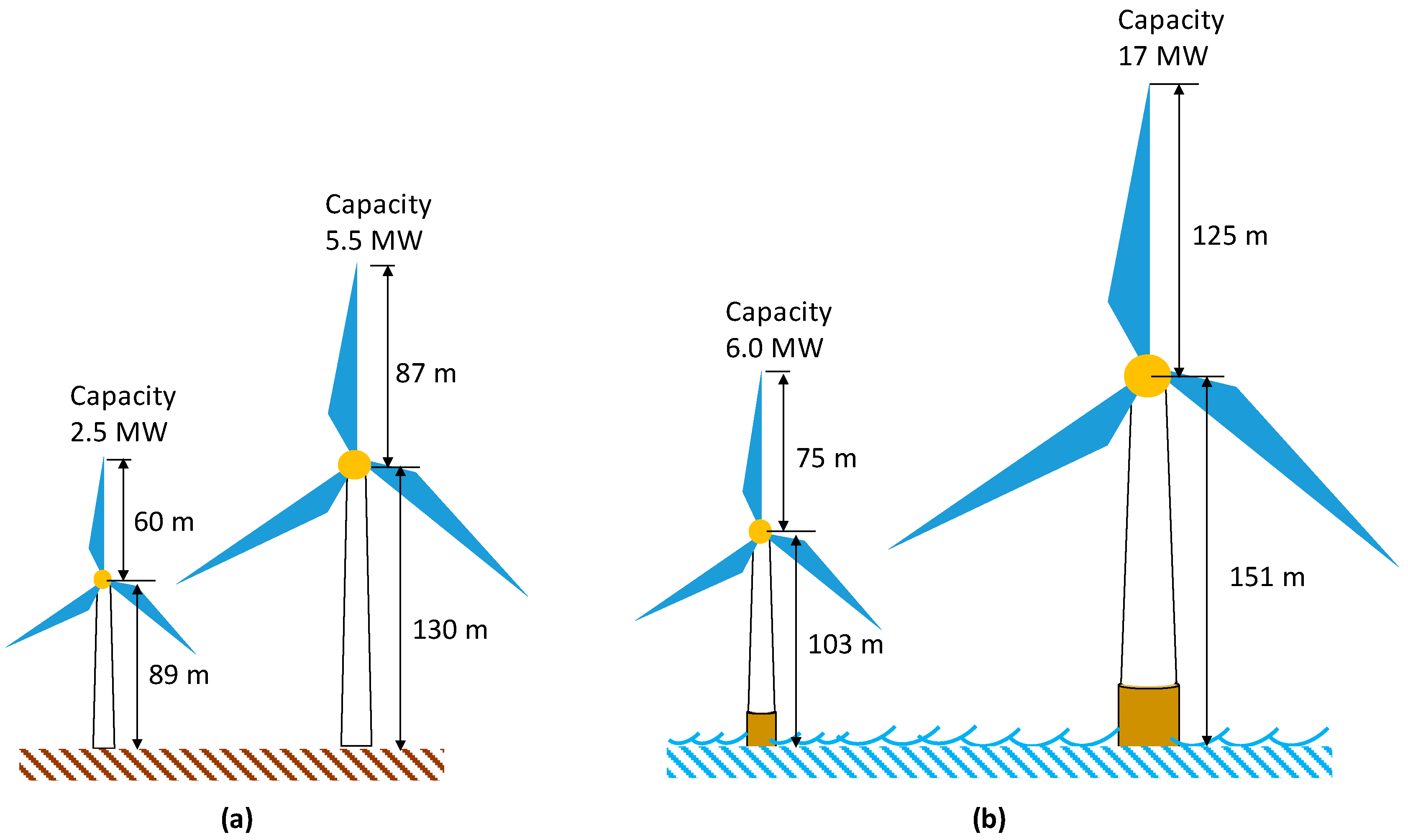
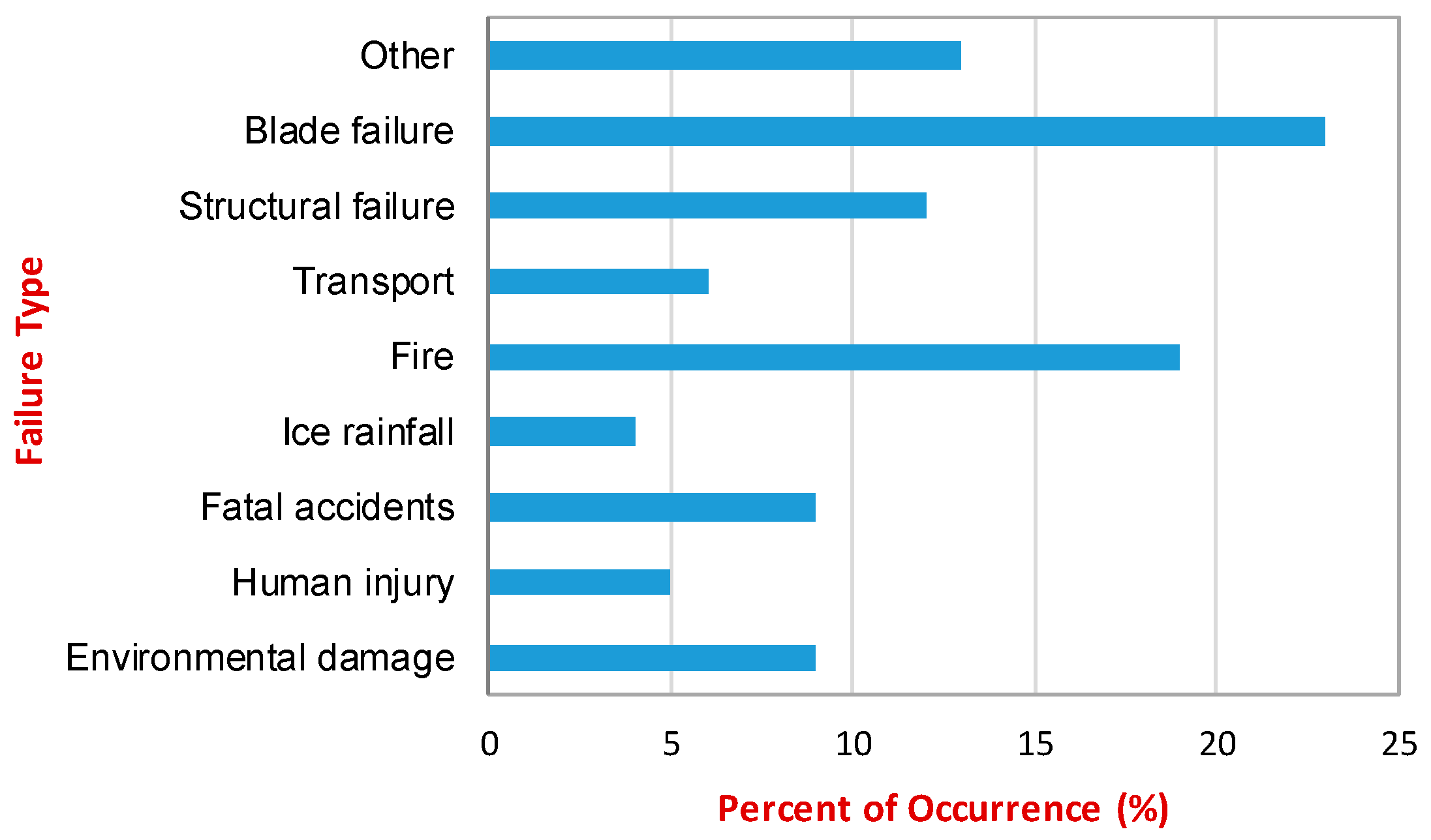
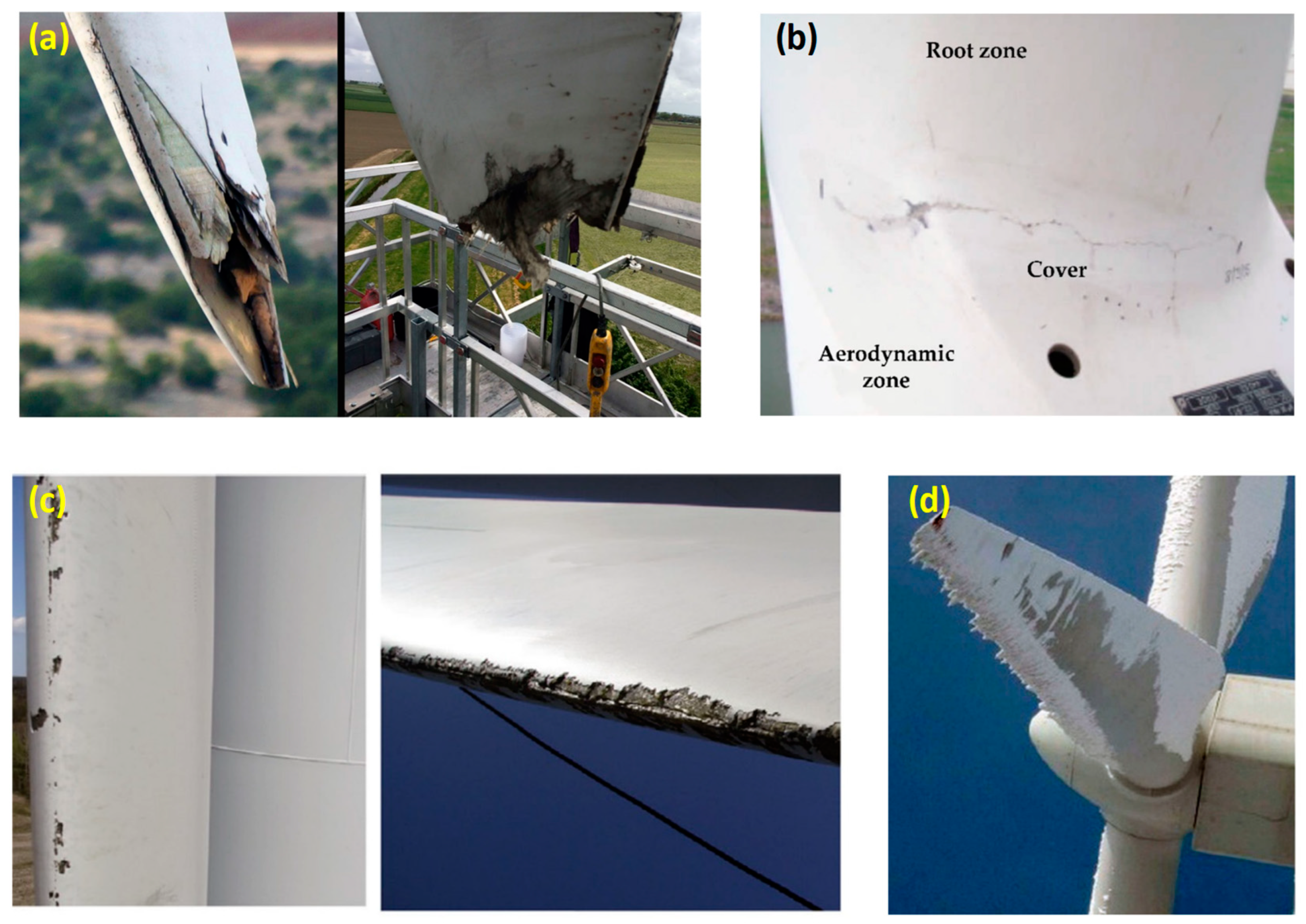
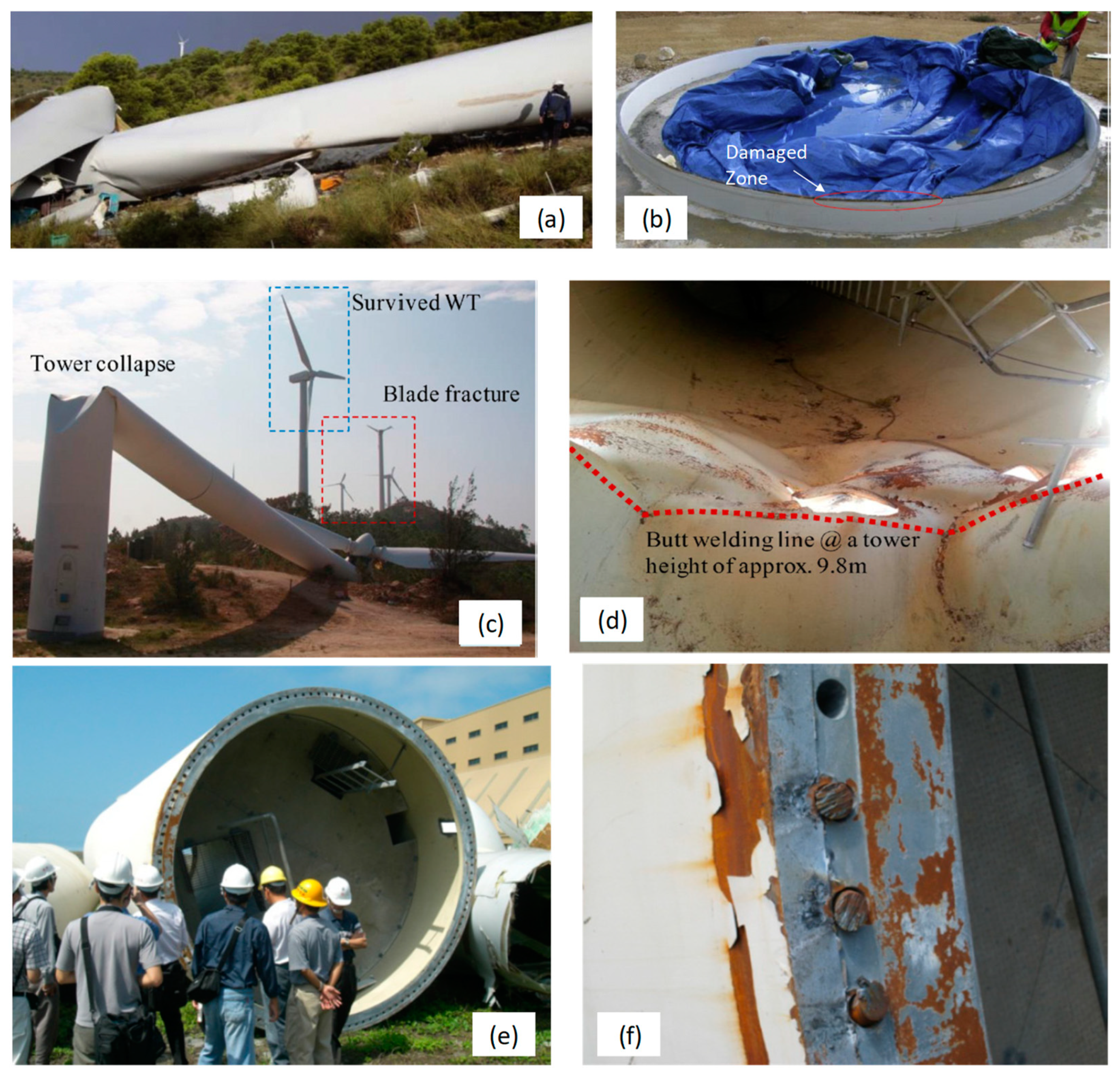
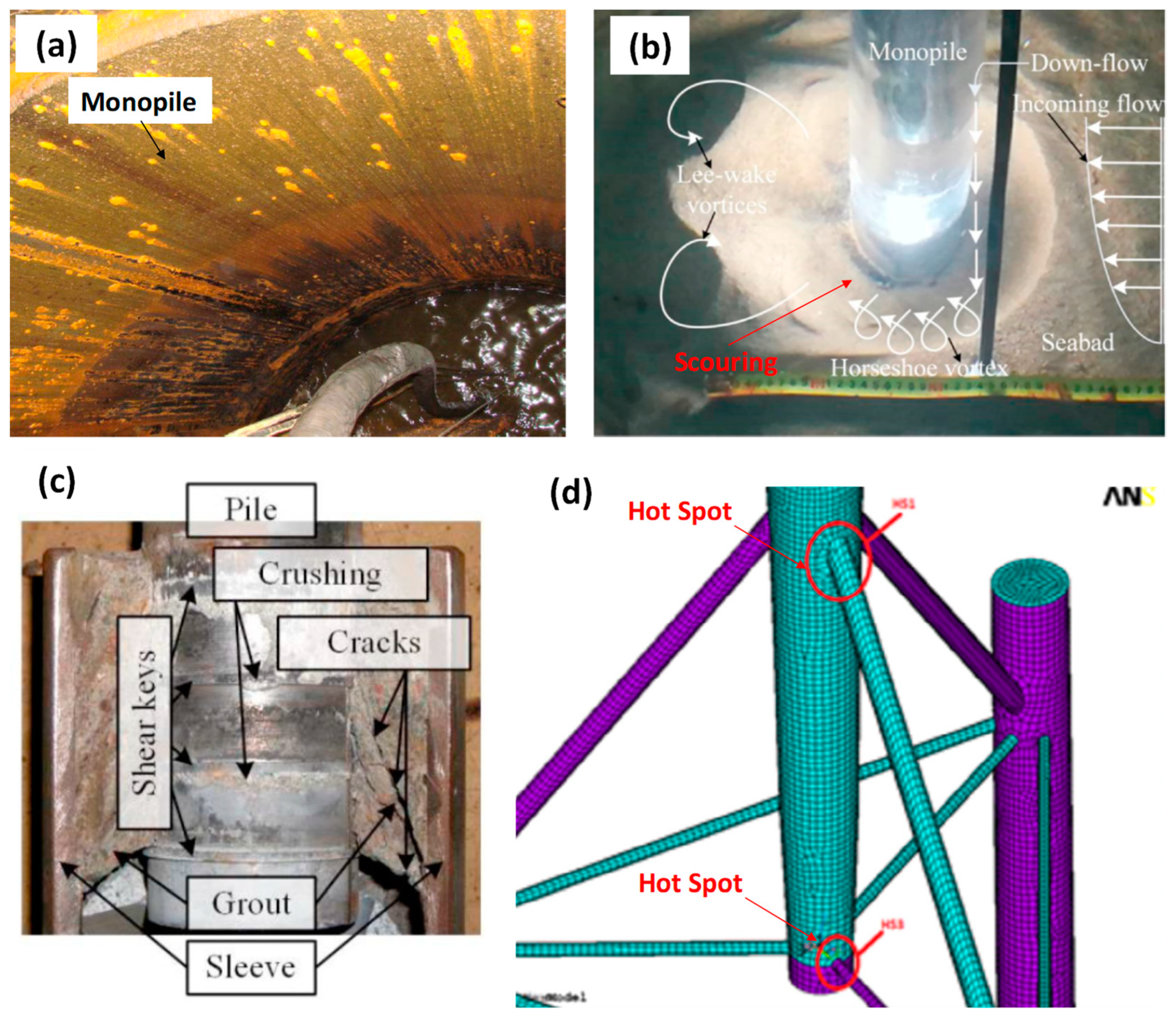
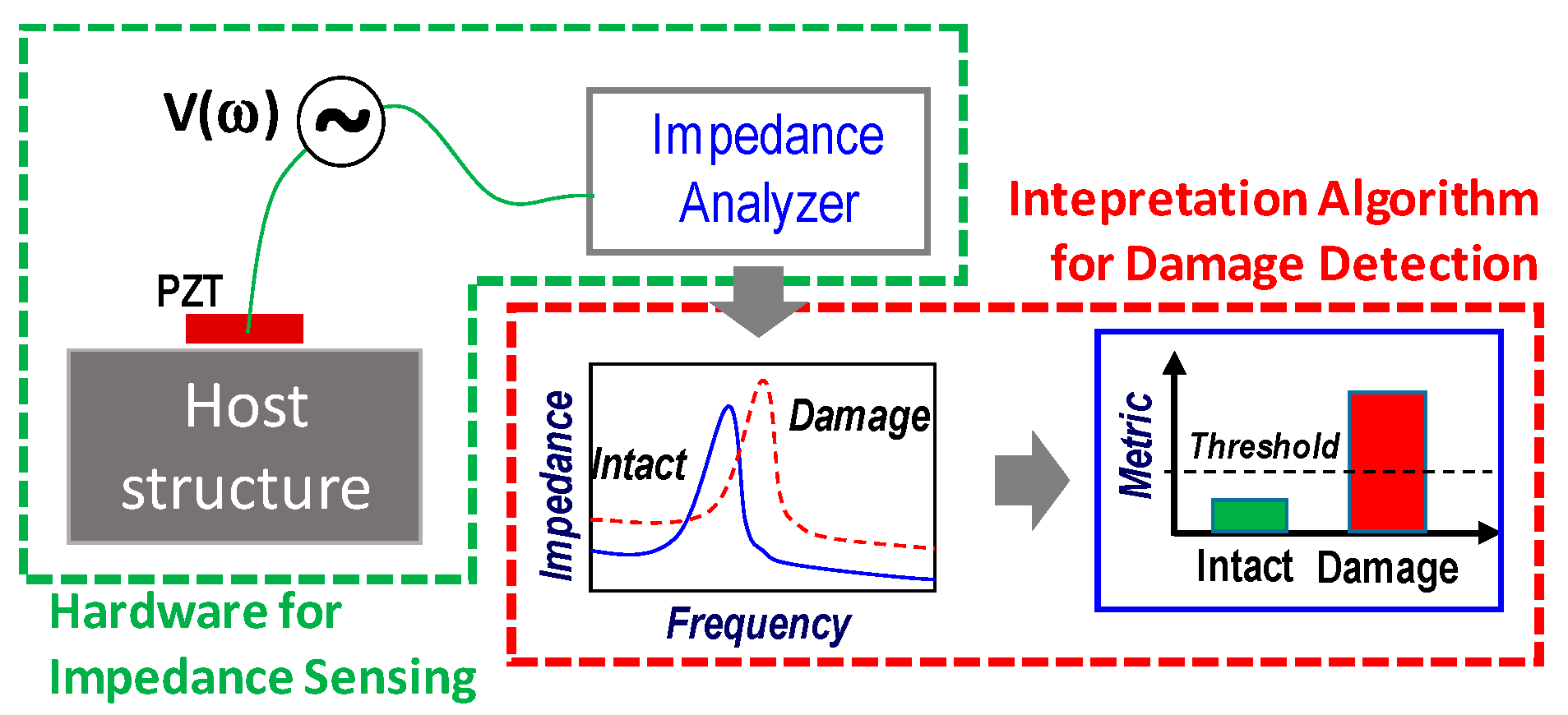
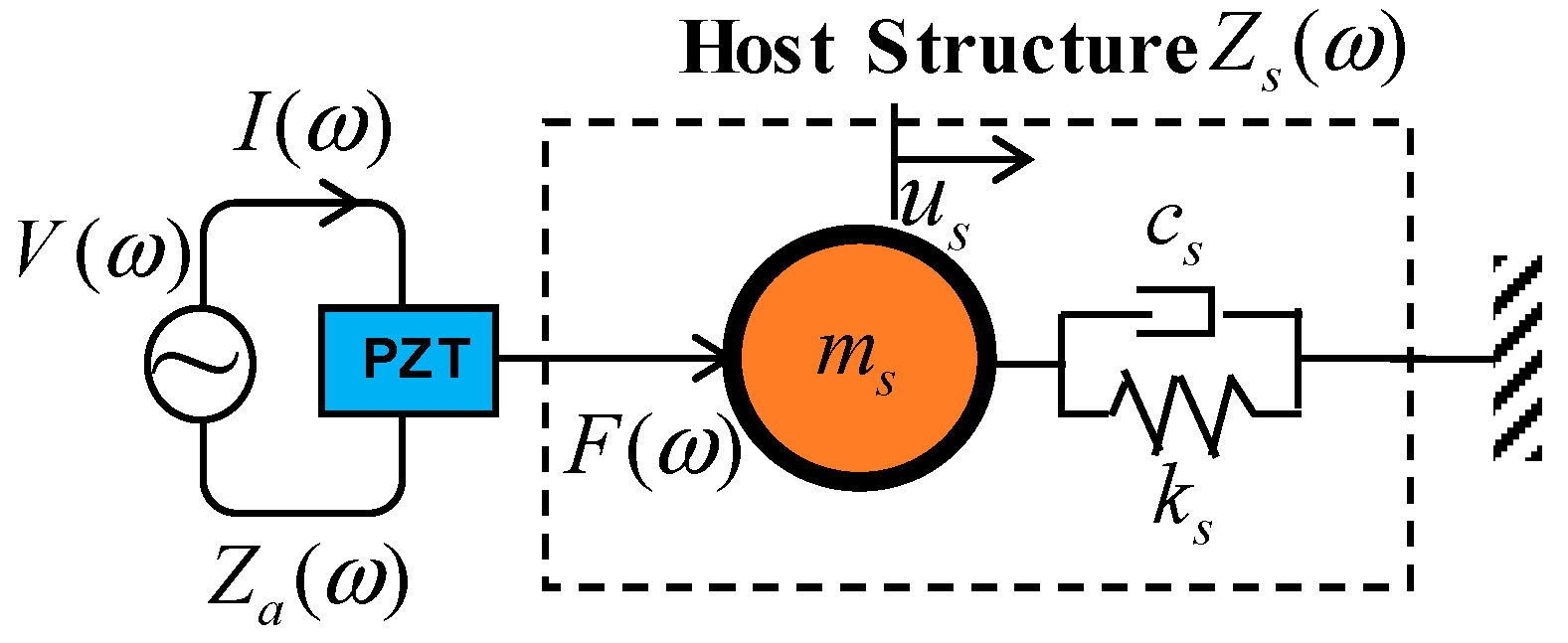
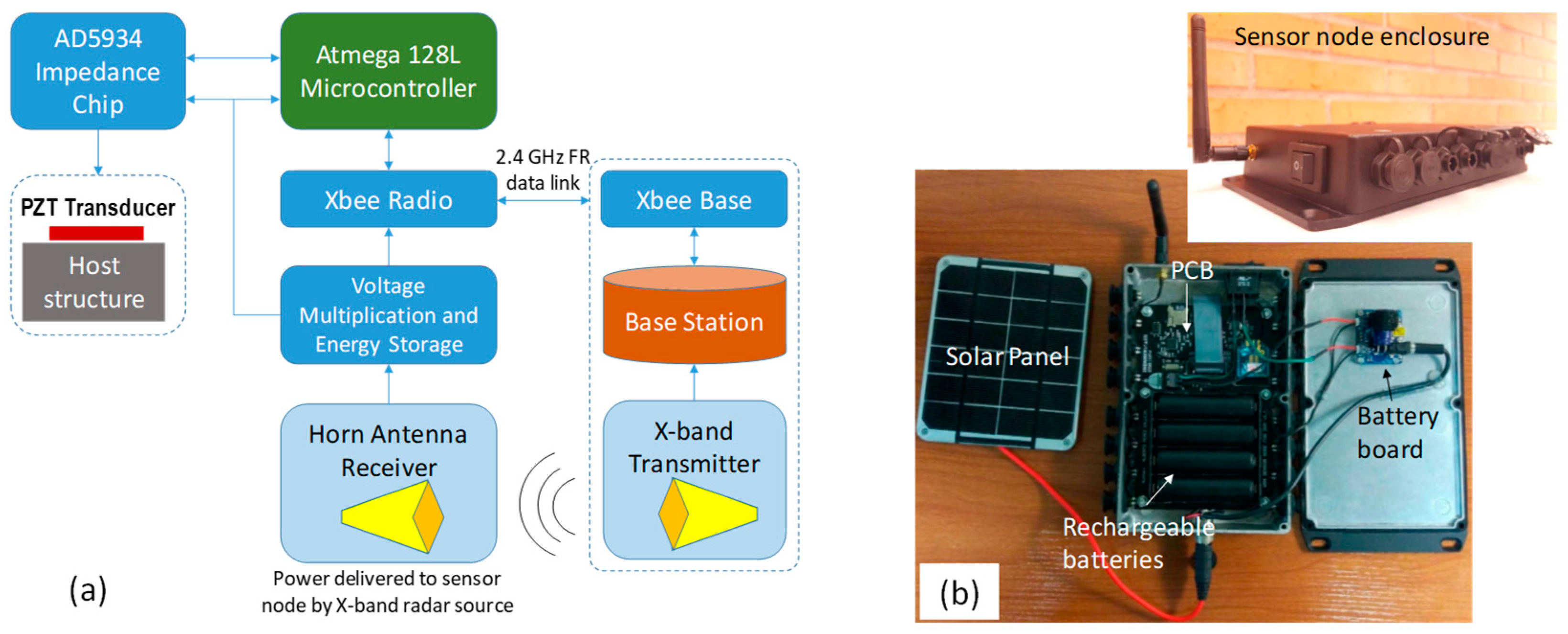
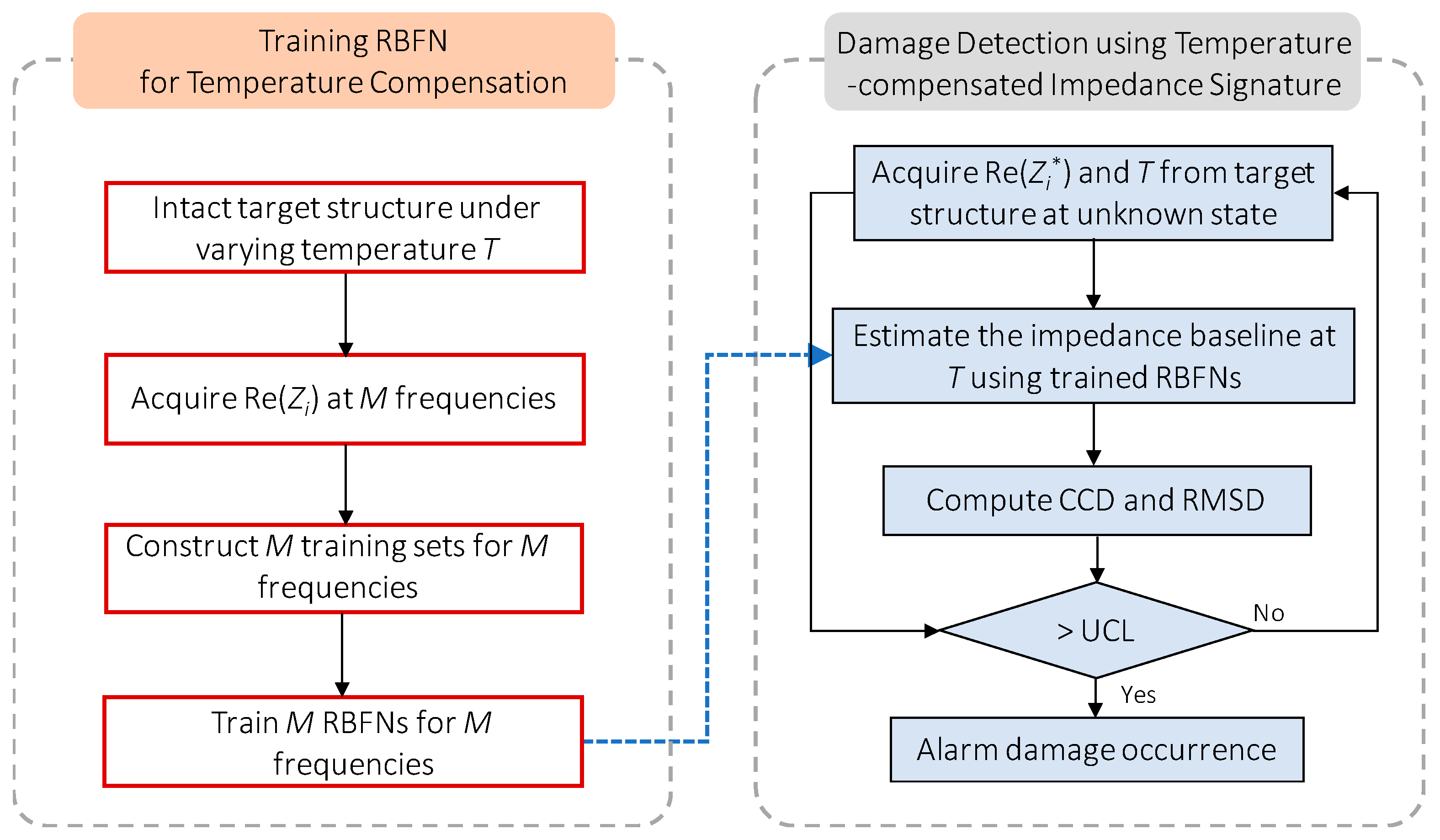
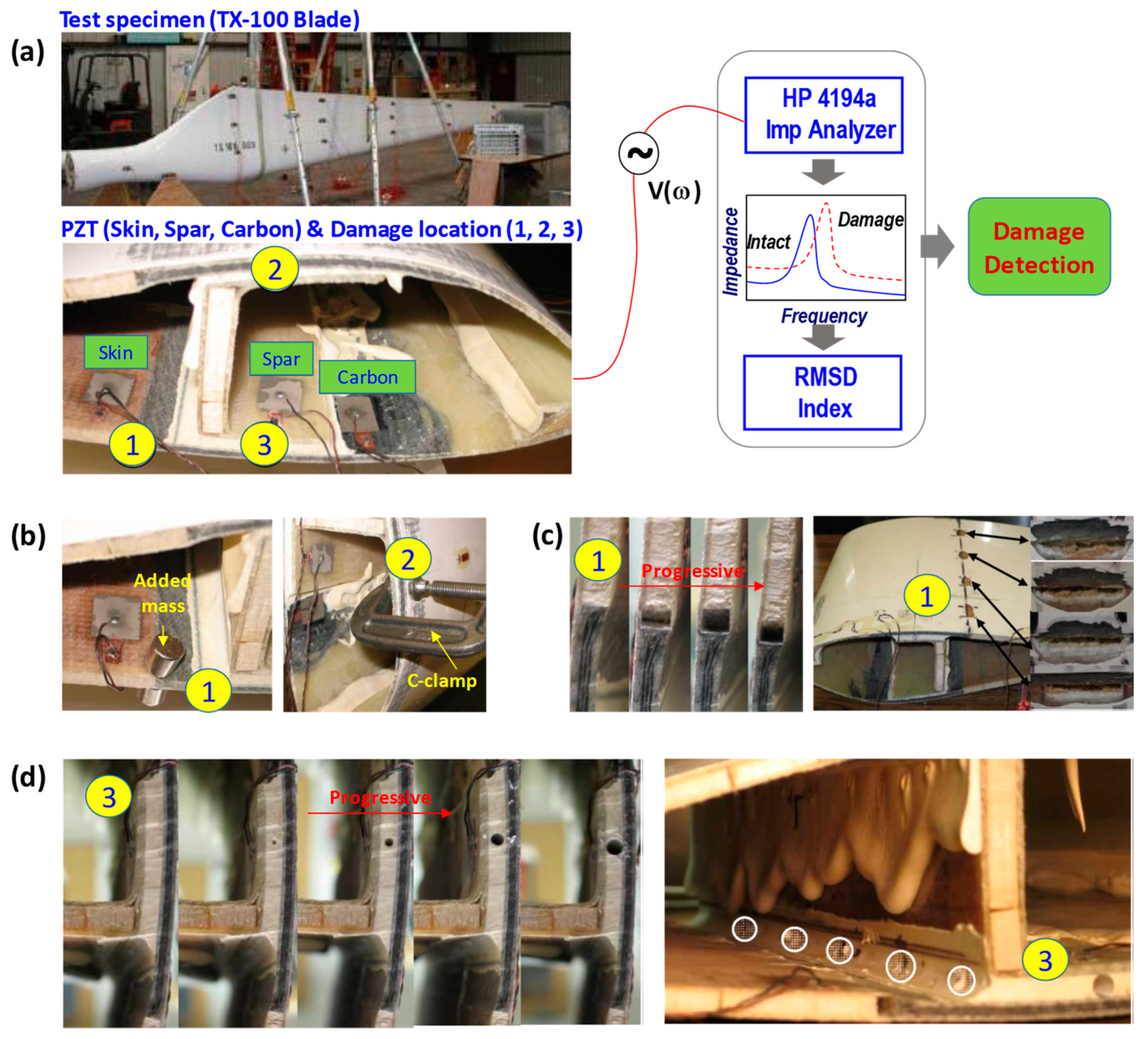

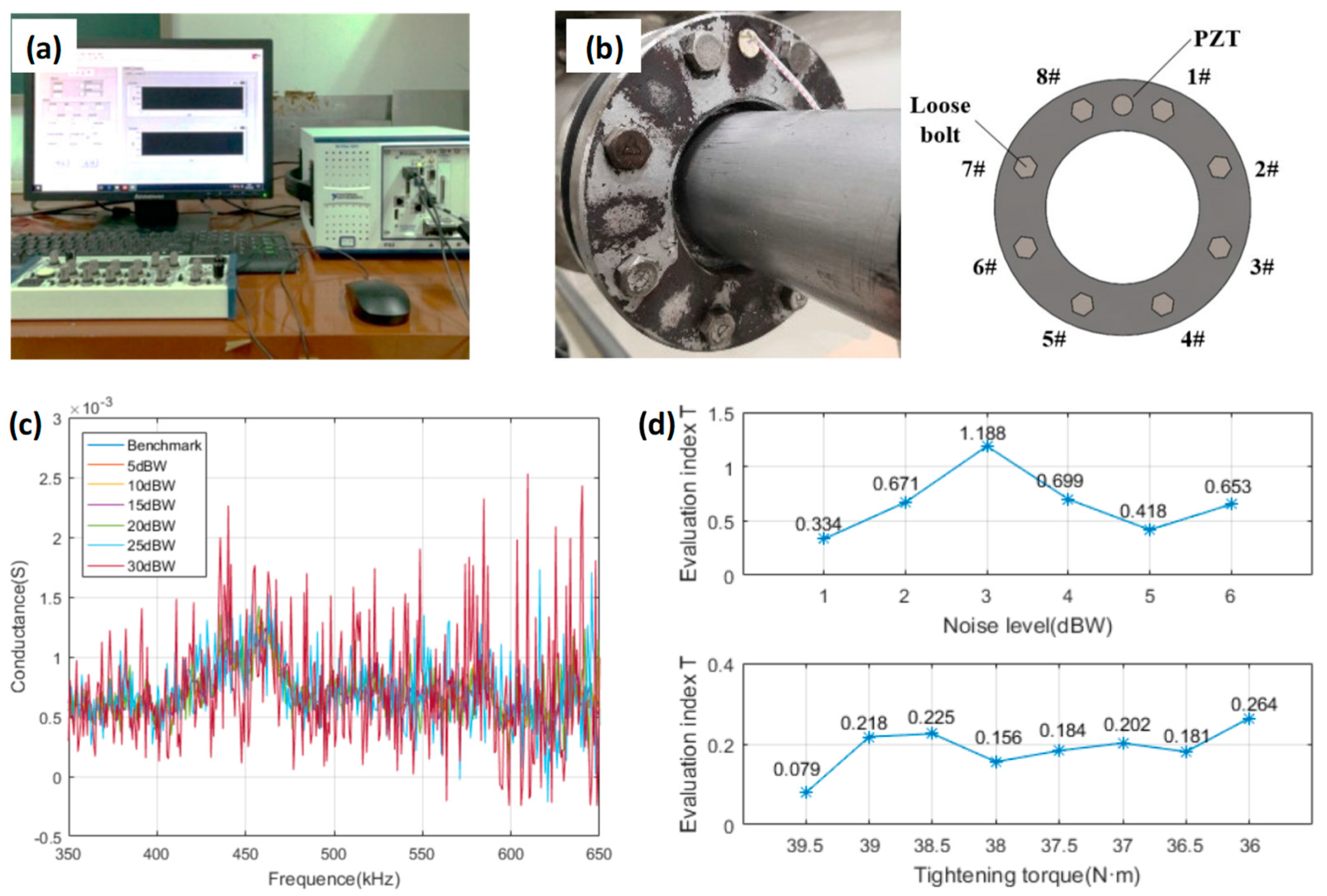
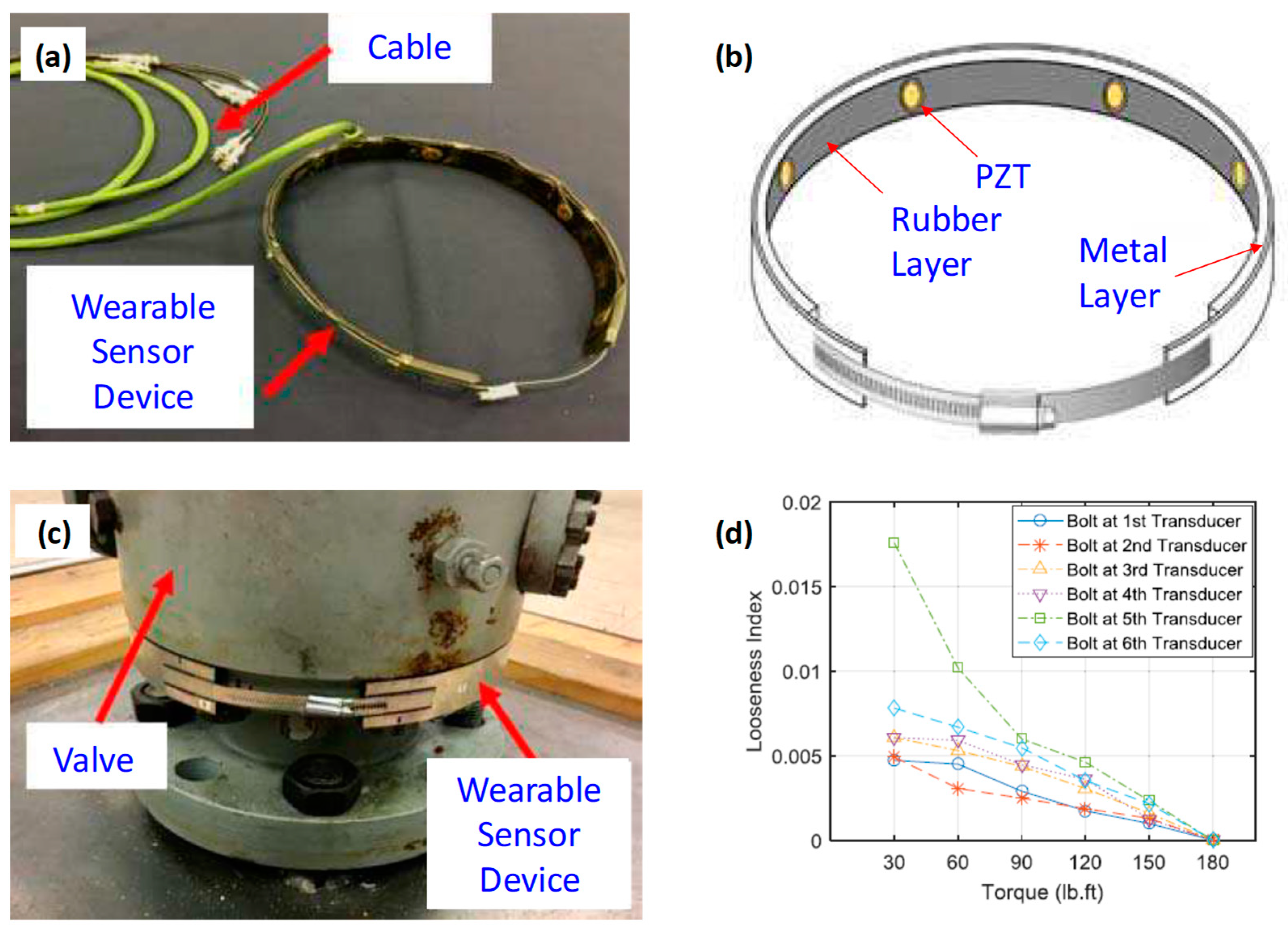

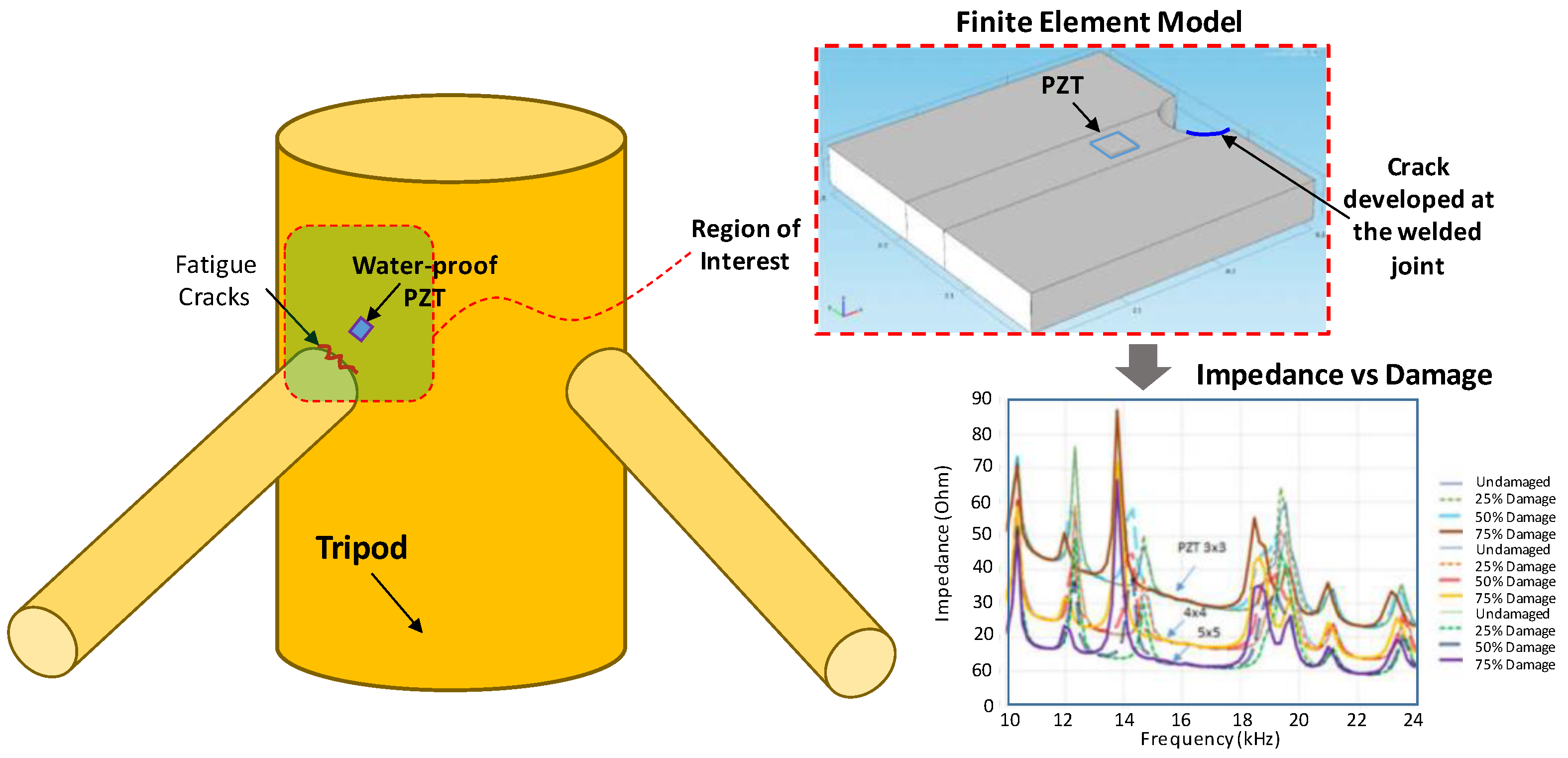
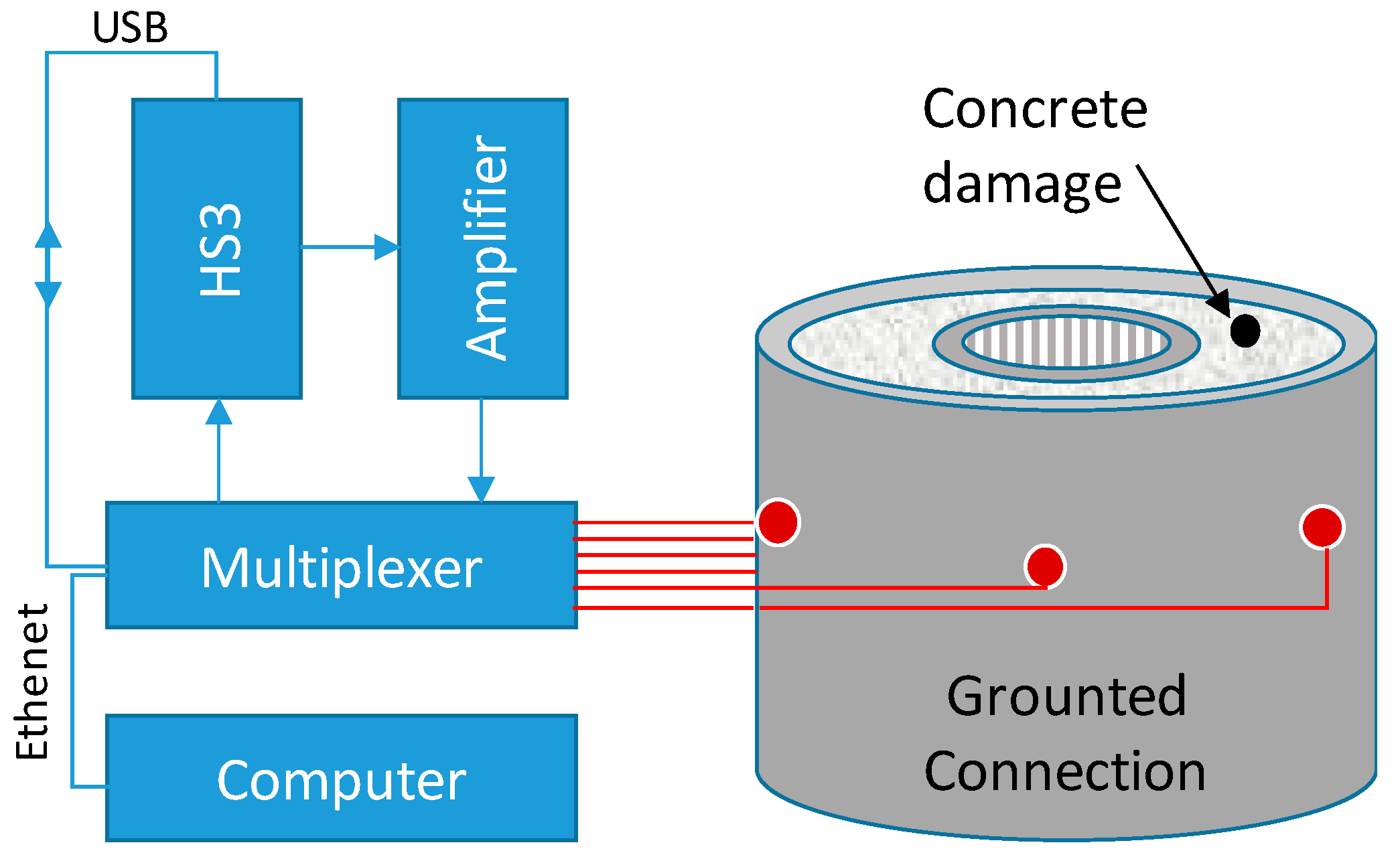
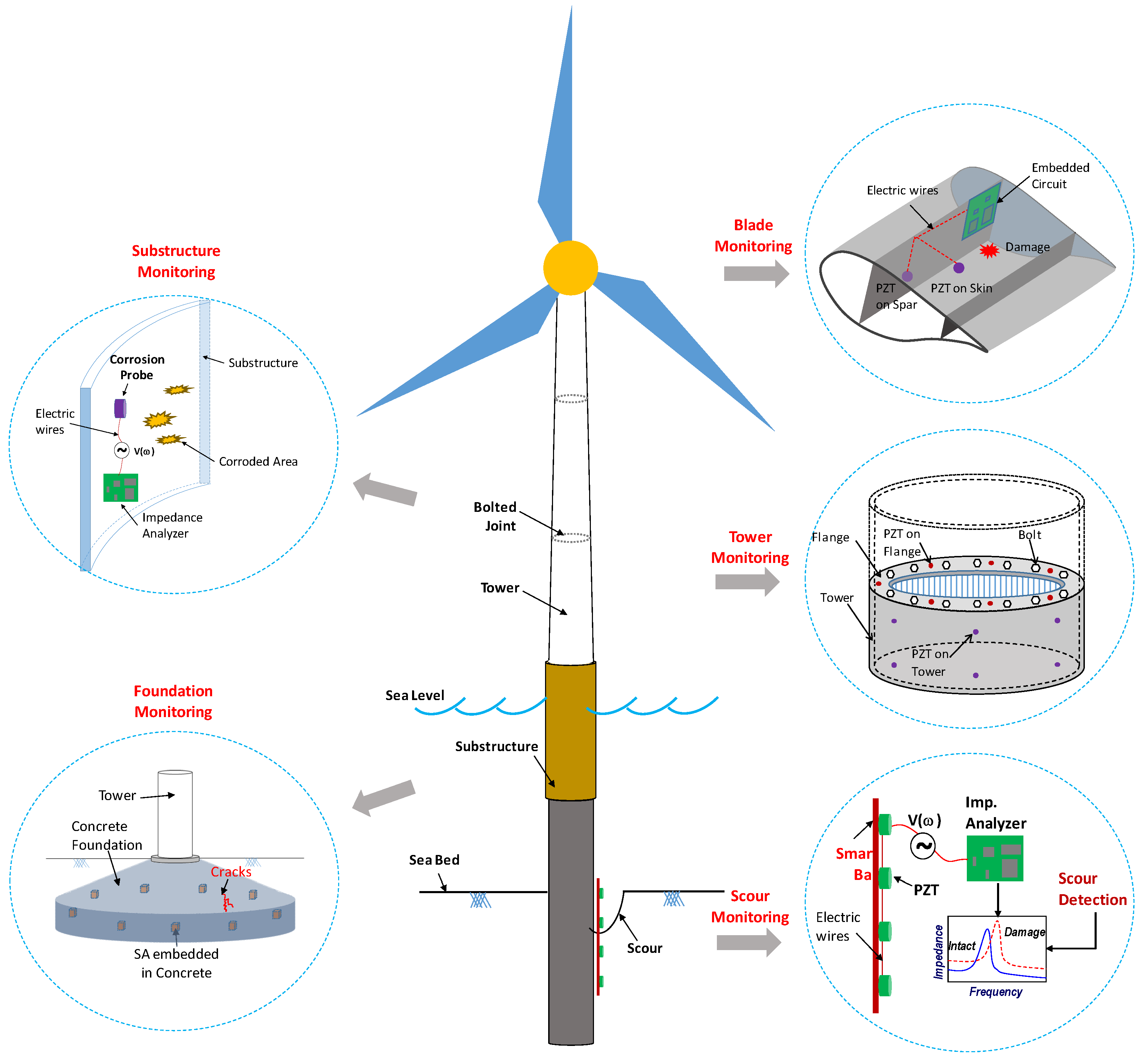
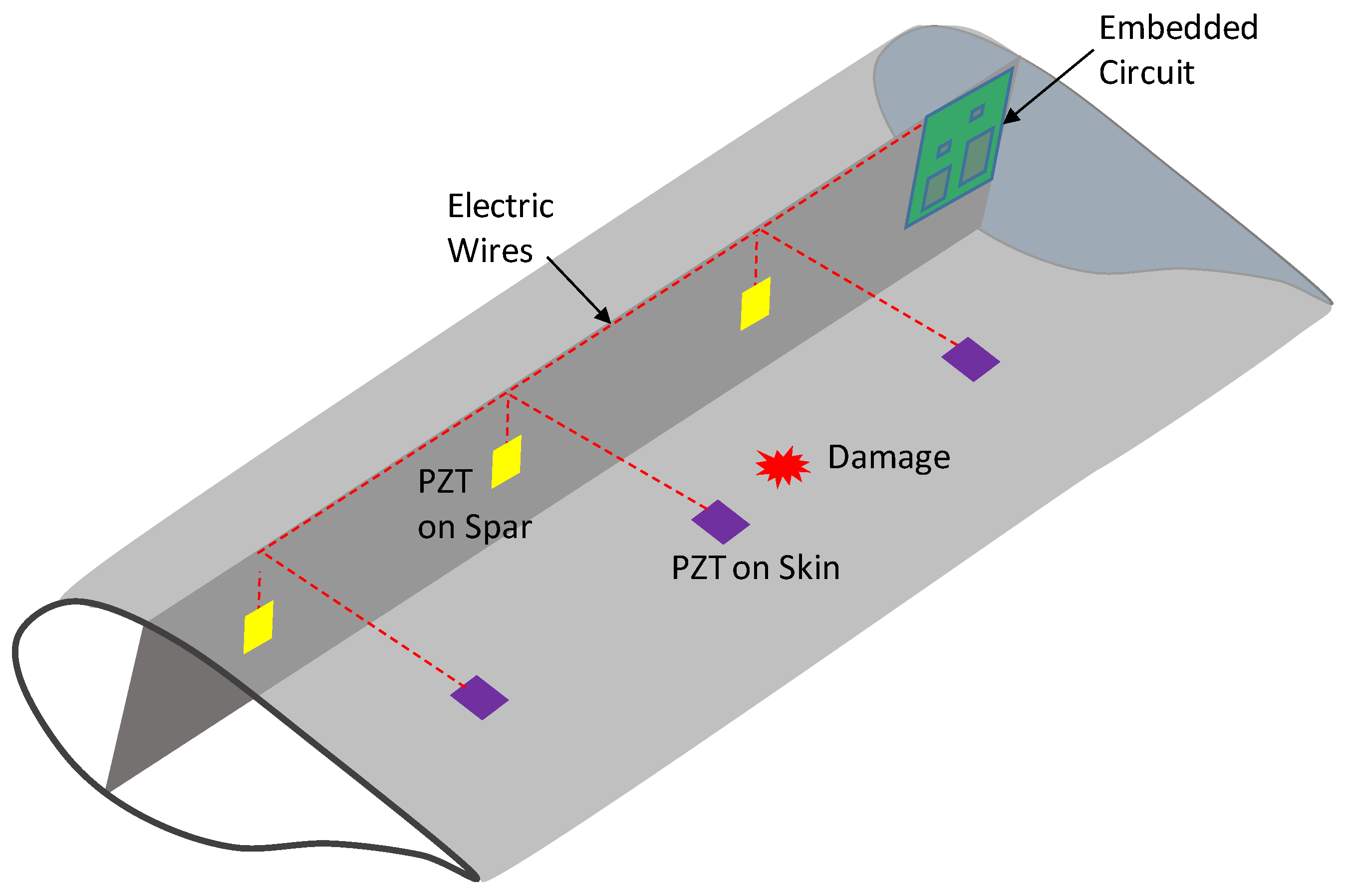
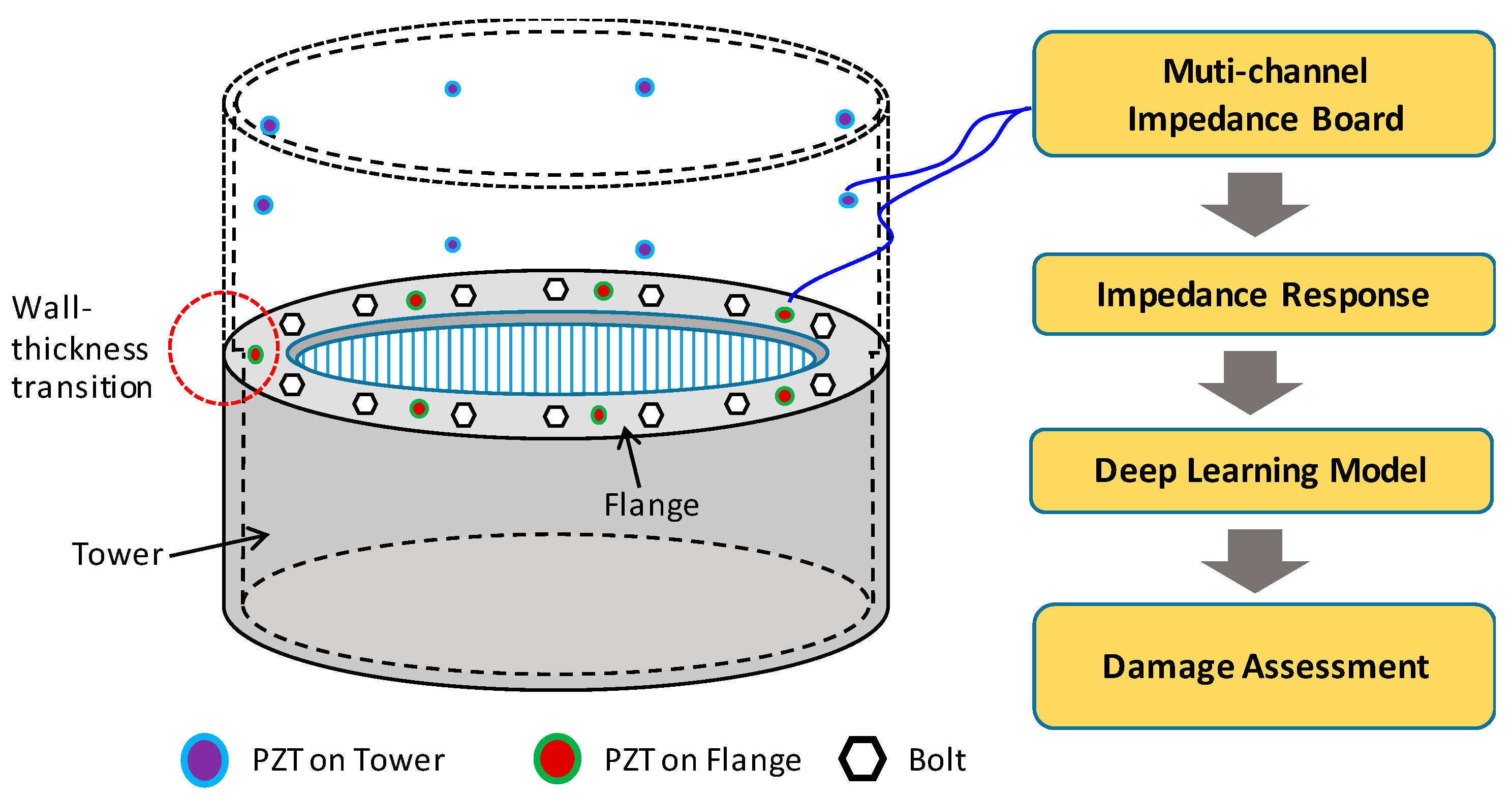
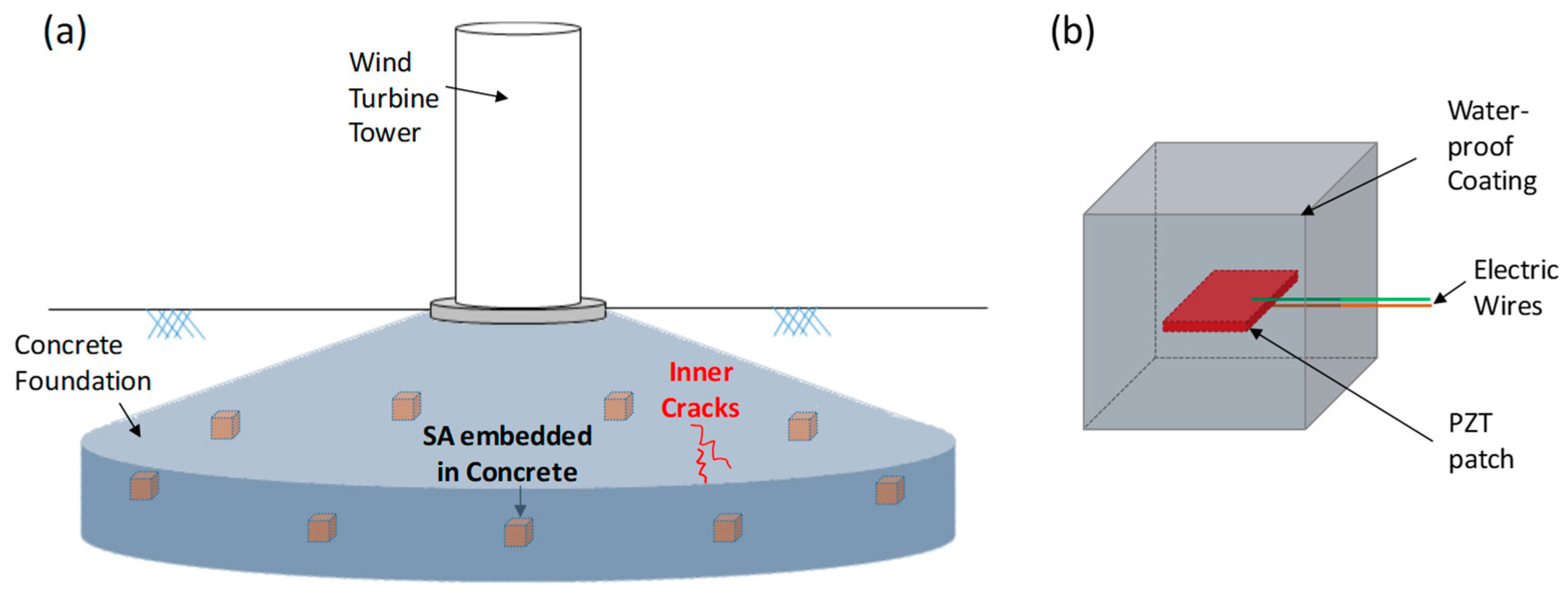
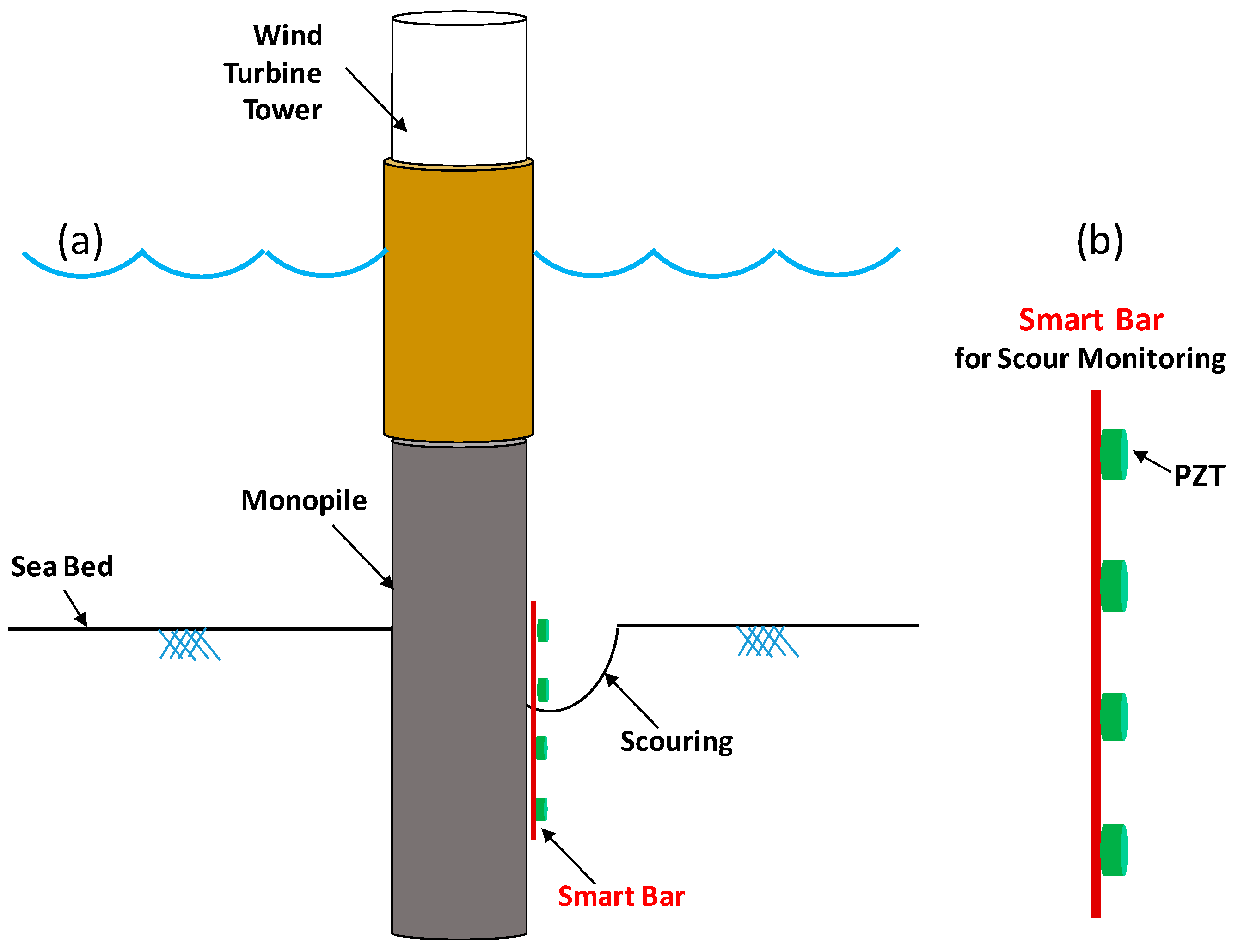
Publisher’s Note: MDPI stays neutral with regard to jurisdictional claims in published maps and institutional affiliations. |
© 2022 by the authors. Licensee MDPI, Basel, Switzerland. This article is an open access article distributed under the terms and conditions of the Creative Commons Attribution (CC BY) license (https://creativecommons.org/licenses/by/4.0/).
Share and Cite
Le, T.-C.; Luu, T.-H.-T.; Nguyen, H.-P.; Nguyen, T.-H.; Ho, D.-D.; Huynh, T.-C. Piezoelectric Impedance-Based Structural Health Monitoring of Wind Turbine Structures: Current Status and Future Perspectives. Energies 2022, 15, 5459. https://doi.org/10.3390/en15155459
Le T-C, Luu T-H-T, Nguyen H-P, Nguyen T-H, Ho D-D, Huynh T-C. Piezoelectric Impedance-Based Structural Health Monitoring of Wind Turbine Structures: Current Status and Future Perspectives. Energies. 2022; 15(15):5459. https://doi.org/10.3390/en15155459
Chicago/Turabian StyleLe, Thanh-Cao, Tran-Huu-Tin Luu, Huu-Phuong Nguyen, Trung-Hau Nguyen, Duc-Duy Ho, and Thanh-Canh Huynh. 2022. "Piezoelectric Impedance-Based Structural Health Monitoring of Wind Turbine Structures: Current Status and Future Perspectives" Energies 15, no. 15: 5459. https://doi.org/10.3390/en15155459
APA StyleLe, T.-C., Luu, T.-H.-T., Nguyen, H.-P., Nguyen, T.-H., Ho, D.-D., & Huynh, T.-C. (2022). Piezoelectric Impedance-Based Structural Health Monitoring of Wind Turbine Structures: Current Status and Future Perspectives. Energies, 15(15), 5459. https://doi.org/10.3390/en15155459






